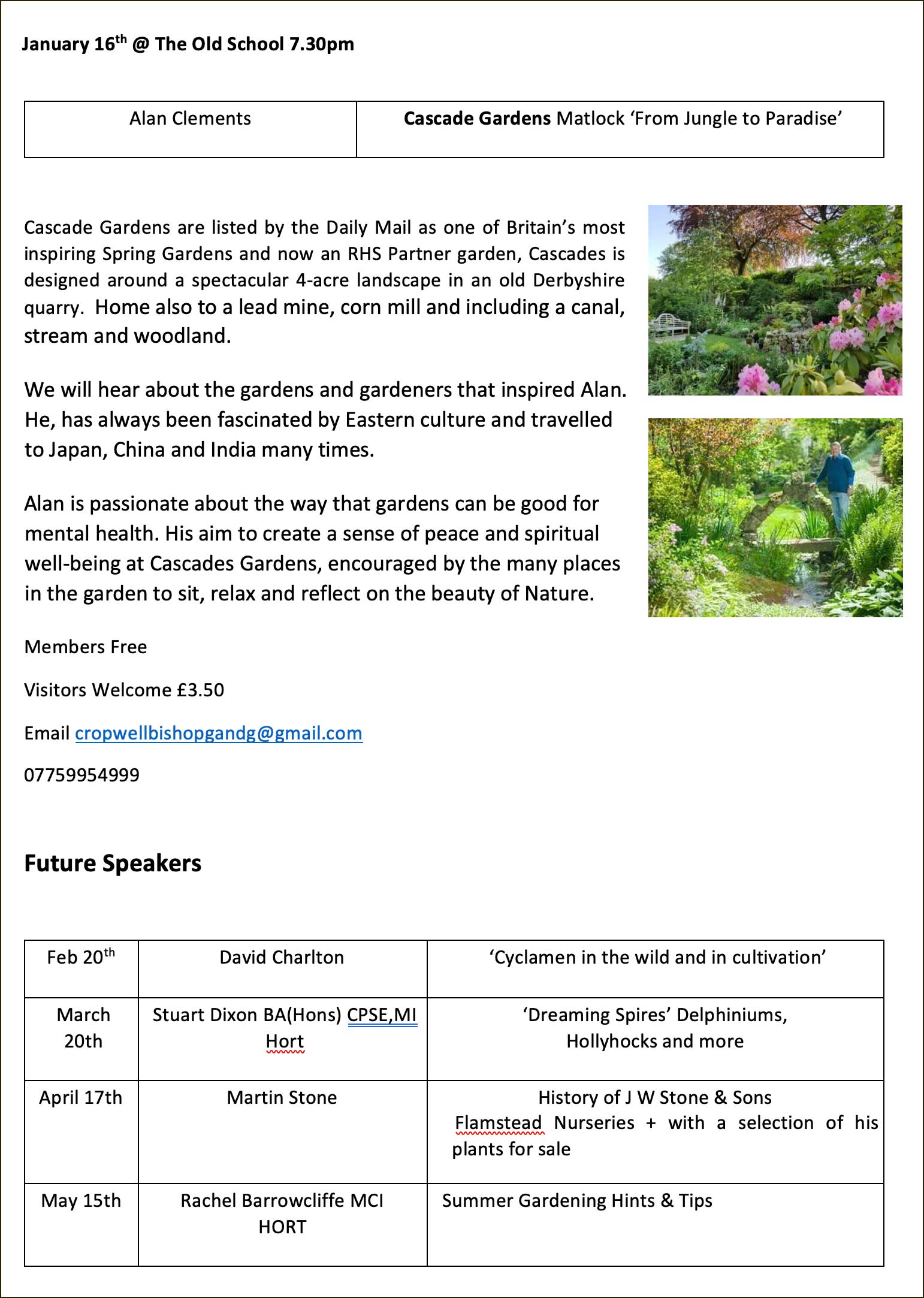
Gardening Club – November 2024 (11-12-24)




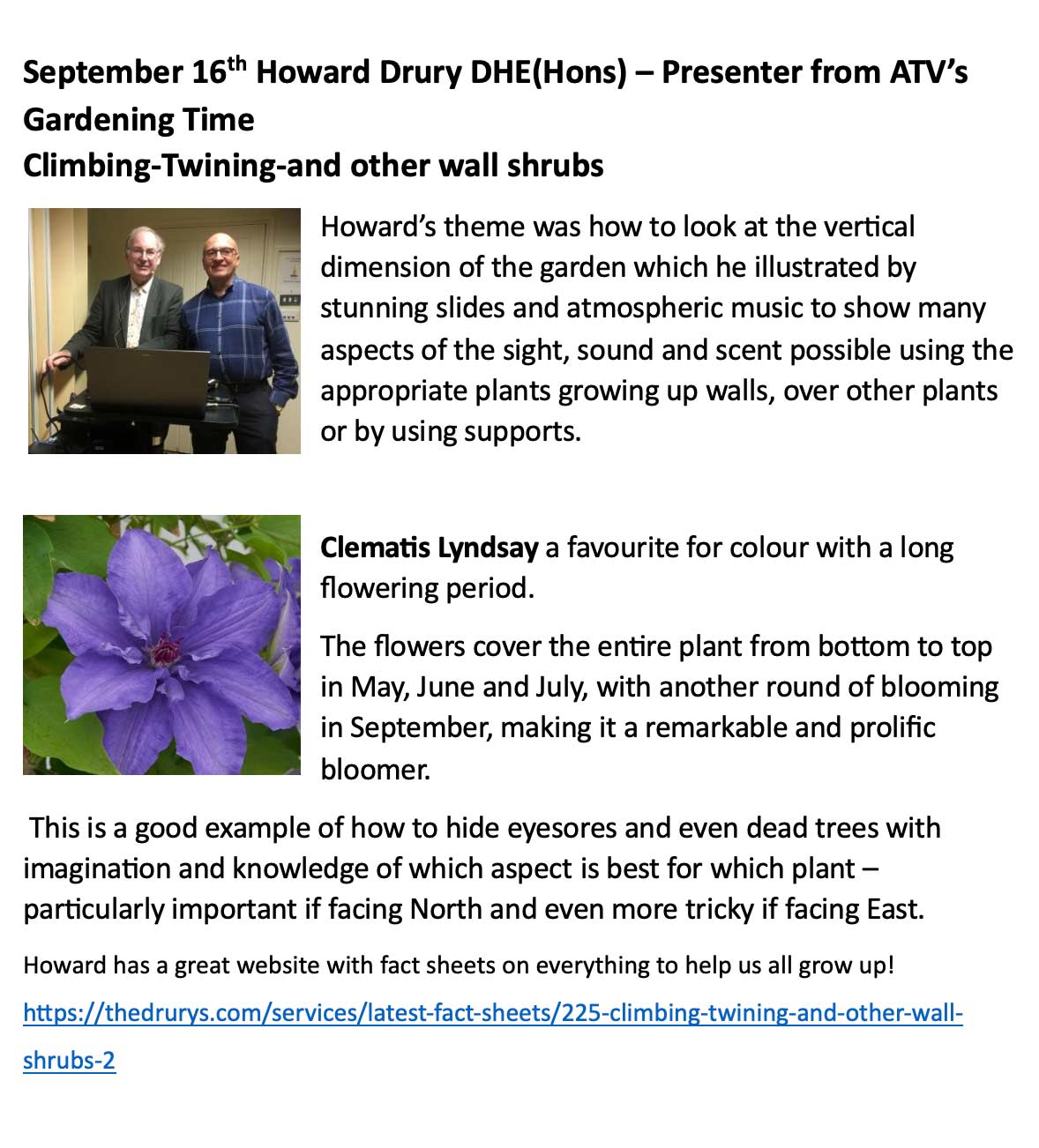



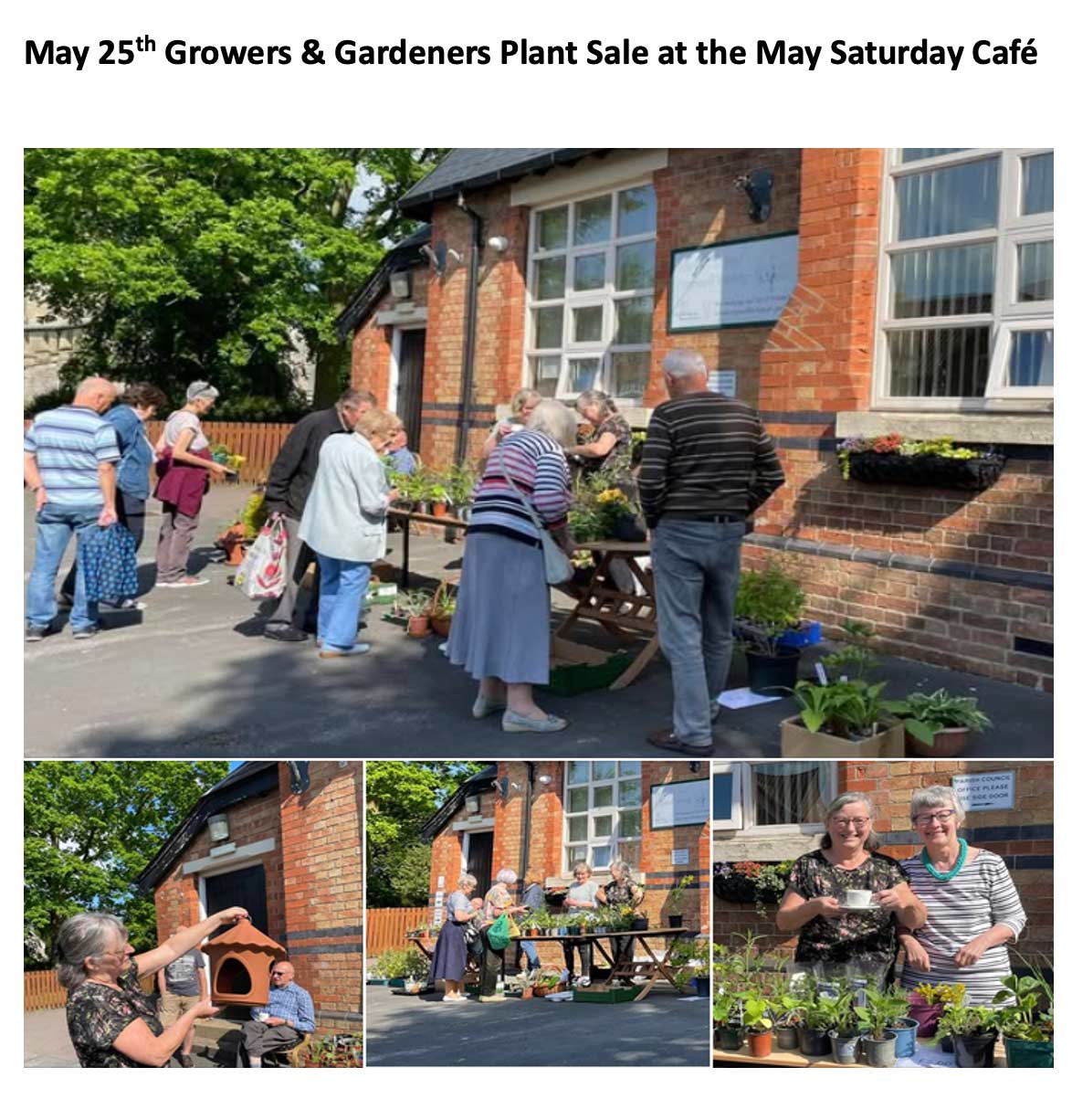











It was the "Growers and Gardeners" AGM this evening.
In no time at all, all the official business was duly completed and all the committee members were unanimously re-elected.
Then it was on to the main event for the evening, a talk and slide show by Mike Davey.
Mike is a highly-qualified, and experienced scientist who, for many years worked for Nottingham University at its Sutton Bonington Campus.
For around 8 years, up to Covid-19, we had a Village Show in Cropwell Bishop and Mike was our judge for all the exhibits that had been grown. It was during those years that Mike worked alongside the Show Committee each September to endeavour that all went off smoothly – and it always did. Judy Thomas was a member of the committee and Mike maintained contact with Judy after the Covid years, during the years of her illness which took her life earlier this month.
Mike put into writing his memories of Judy and has given me permission to repeat them below:
As a fellow gardener, I first met Judy when the newly formed Cropwell Bishop Gardening Club invited me to talk at one of their meetings and shortly later when your members visited our garden in Ruddington for afternoon tea.
Judy and others invited me to give subsequent talks to your gardening club. I always enjoyed the way Judy chaired the meetings in her organised and friendly way, encouraging everyone to take part to improve their gardening interests.
It was always a pleasure judging at your Horticultural and Village Shows and to discuss with Judy and colleagues the entries. Judy’s baskets of vegetables were always delightful; they reflected her artistic skills and her attention to detail.
She led by example and was full of encouragement for everyone, especially children, as she recognised them as our future gardeners.
I especially enjoyed seeing her wild-life cottage garden with its wonderful display of insect-friendly flowers.
I last met Judy when she visited our garden again during the summer of 2022 with members from Cropwell Butler and Cropwell Bishop. In a quiet moment we talked about health problems; Judy emphasised the need to keep pressing ahead, to initiate new projects and to keep as active as possible even during very demanding times.
Clearly, a lady of immense courage and determination. Everyone will miss Judy so much, but I know we will retain fond memories of the time we spent together.
It was a great privilege to have had the opportunity to know her.
Thank you Mike for your kind words.
Back to this evening. Mike could have happily talked about plants, but he has a wide range of interests and is forever involved in village projects in his own village of Ruddington.
This evening he shared his passion for country walks in this area of South Notts that we all live in. With numerous slides and an informative commentary, we were treated to a tour of off-road routes and sites that I, or one, never knew existed – and all within half-an-hour of Cropwell Bishop.
Here are a few pictures that I captured from the show.
Tony Jarrow
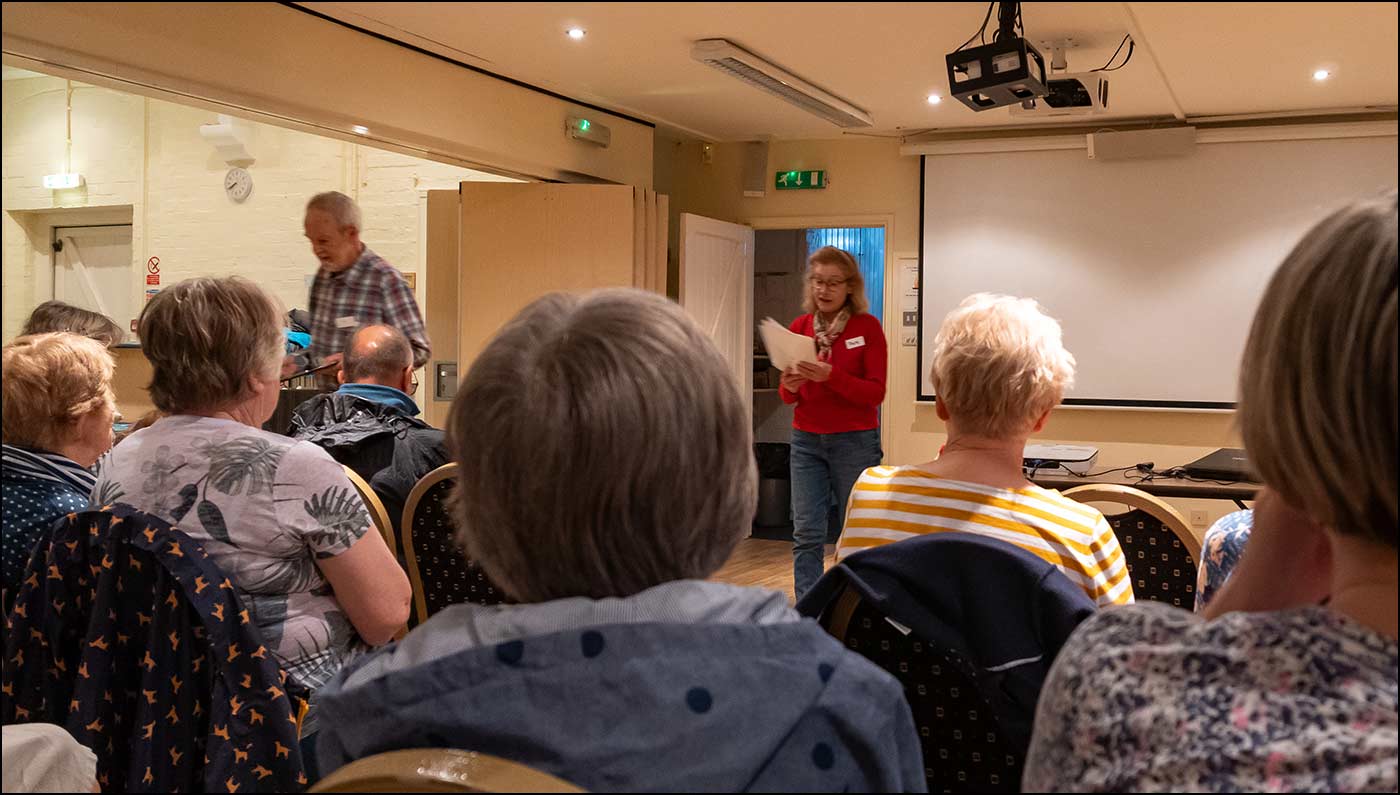

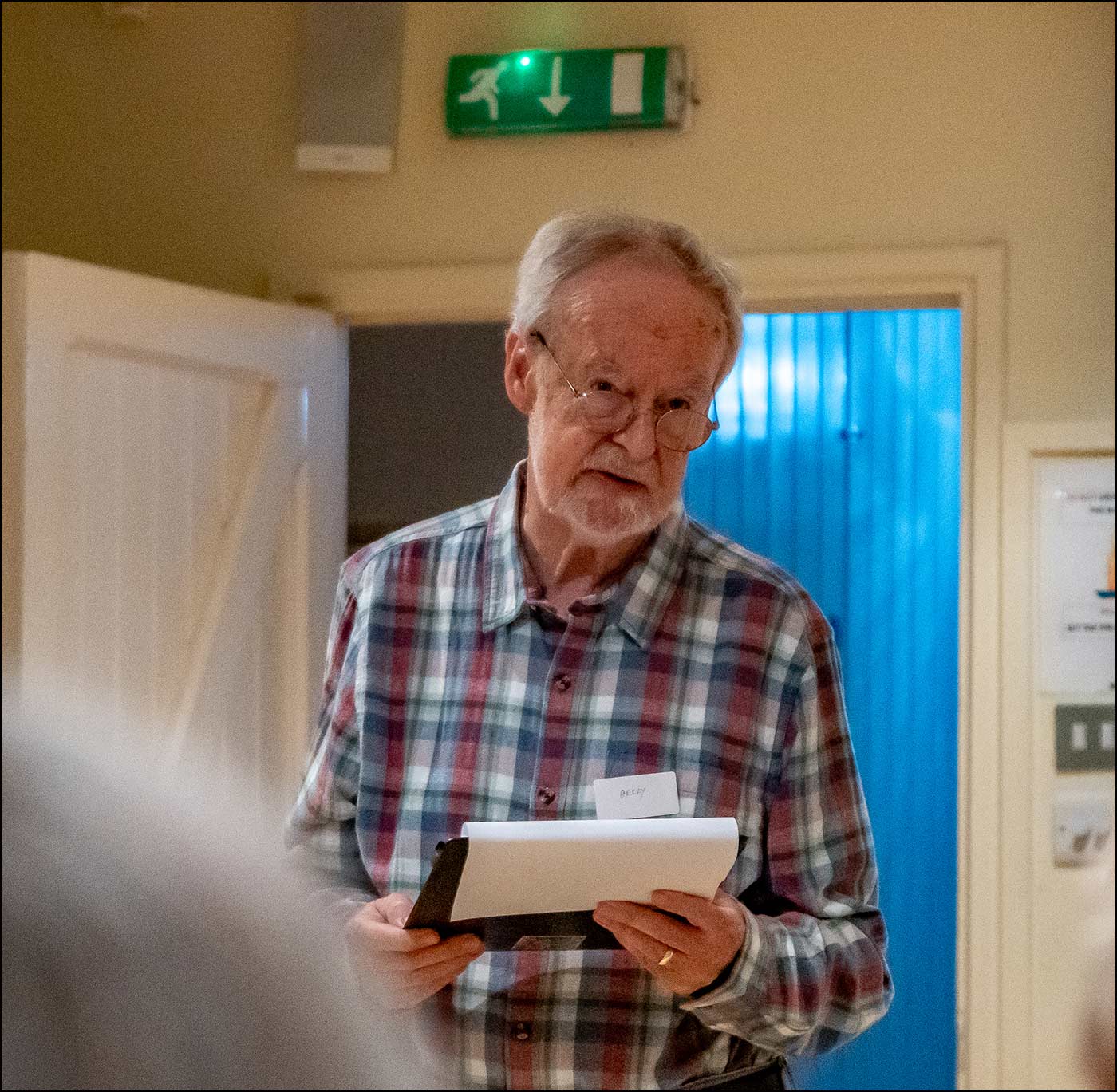
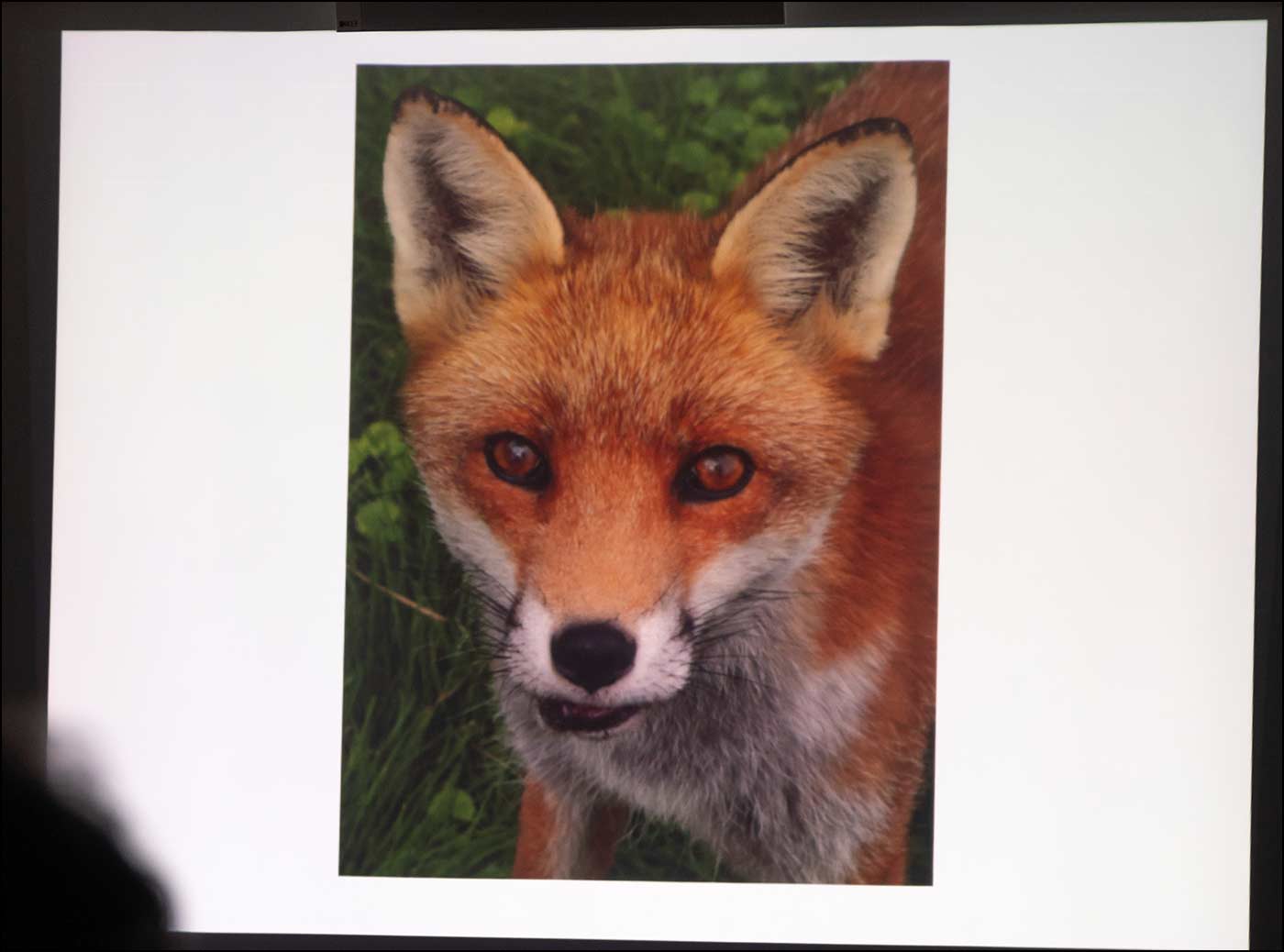
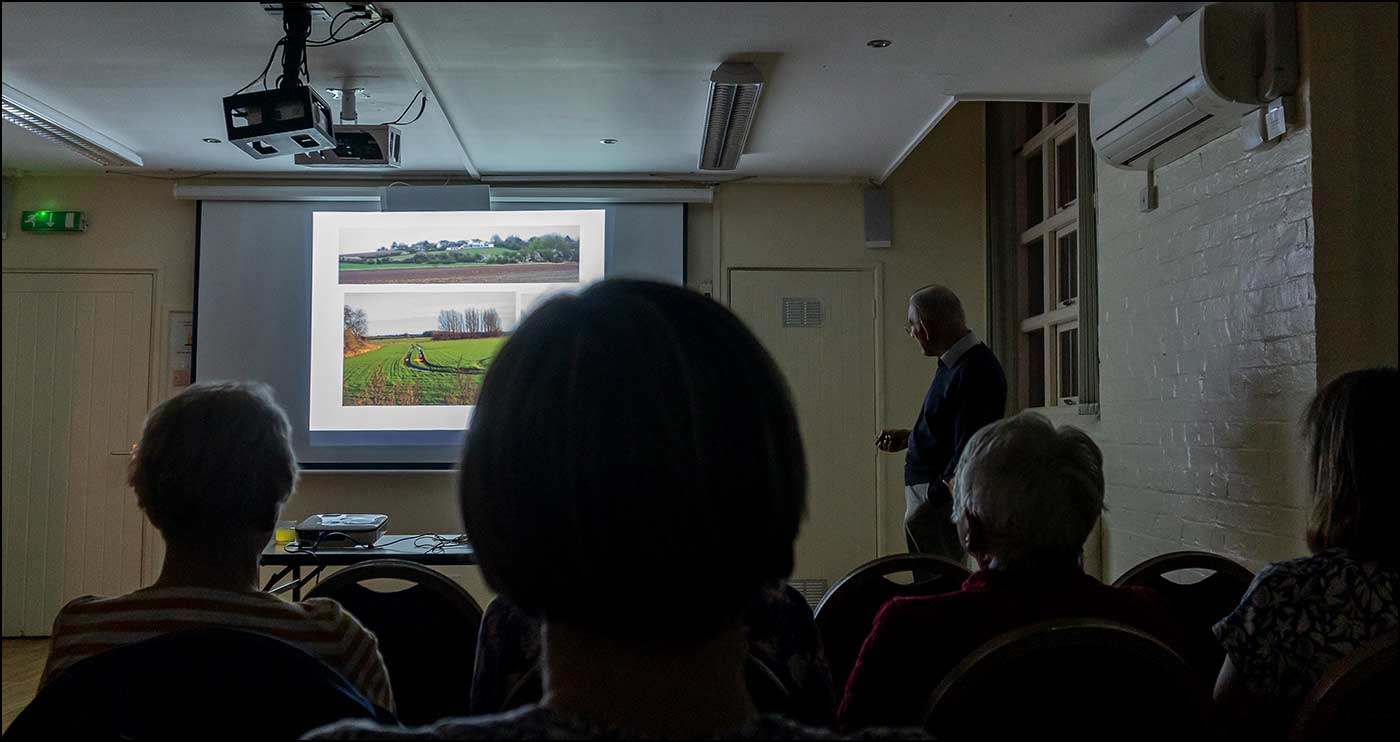
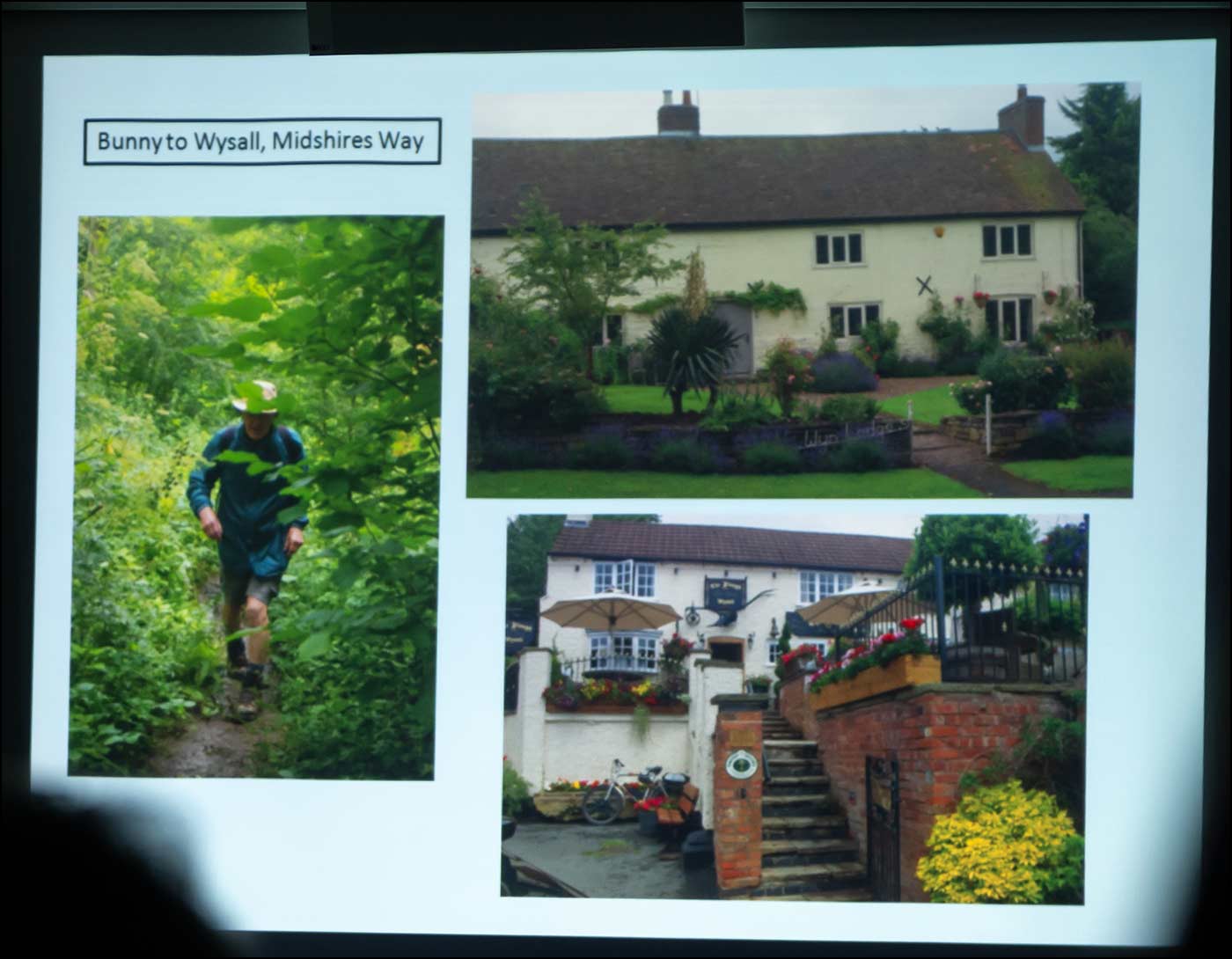


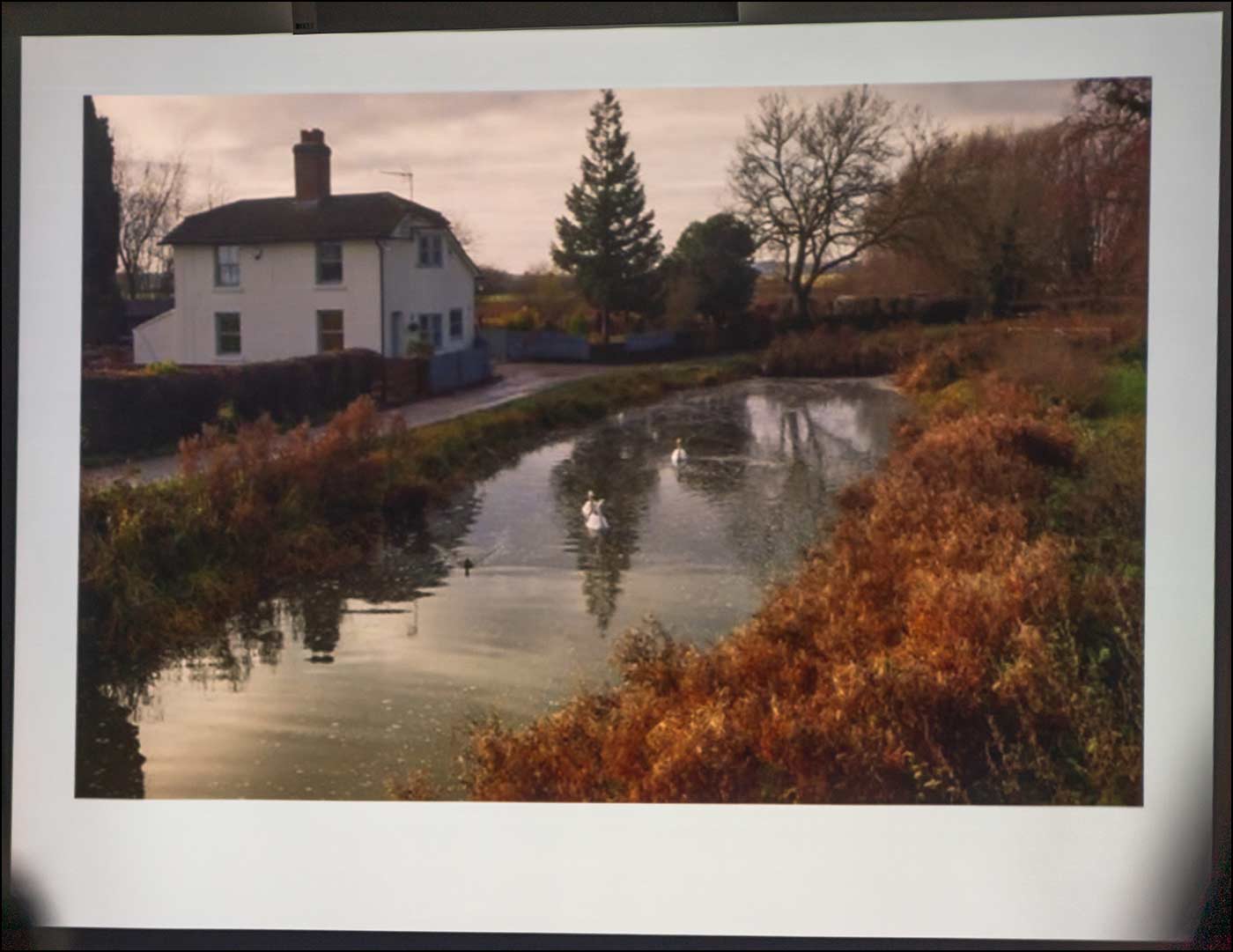


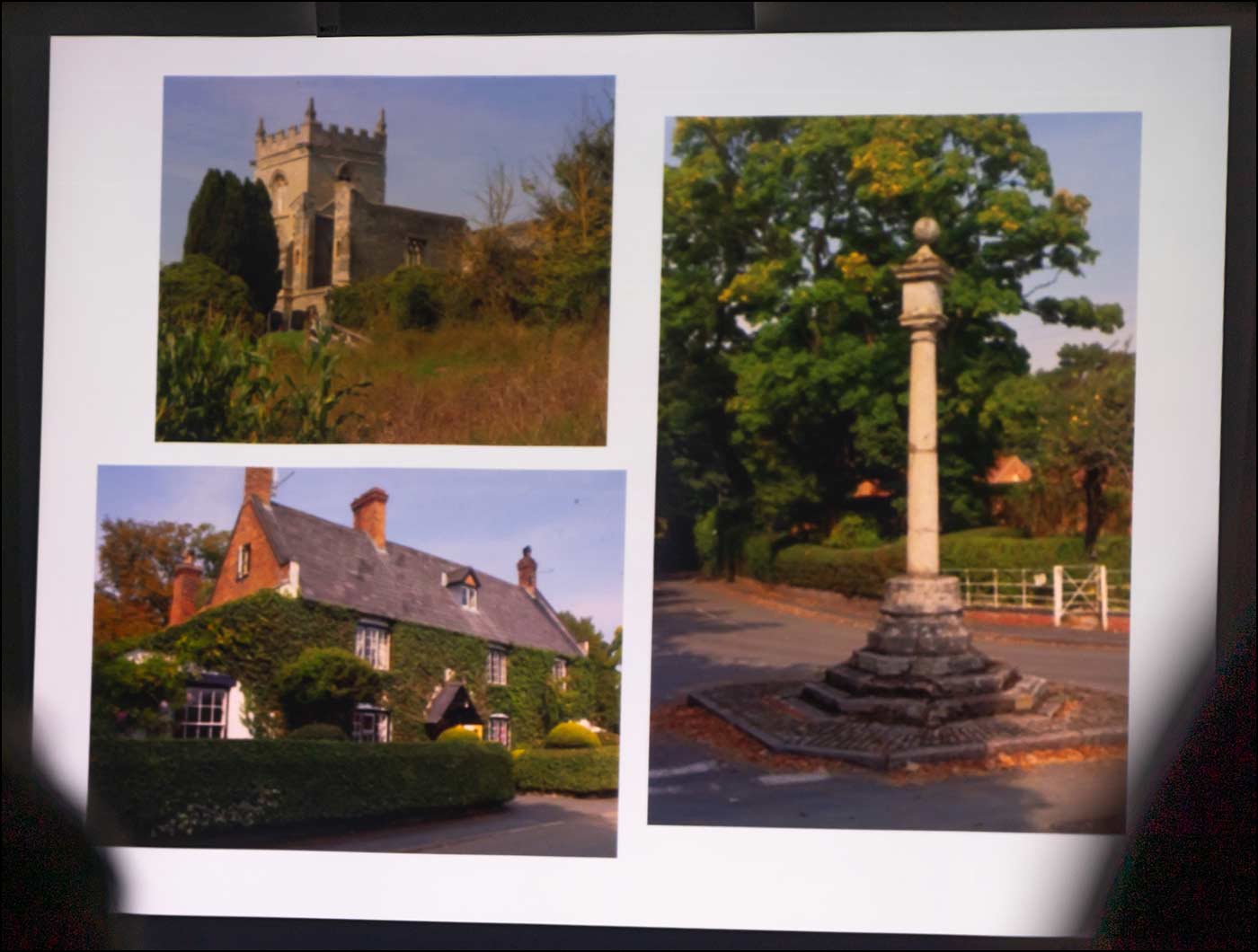
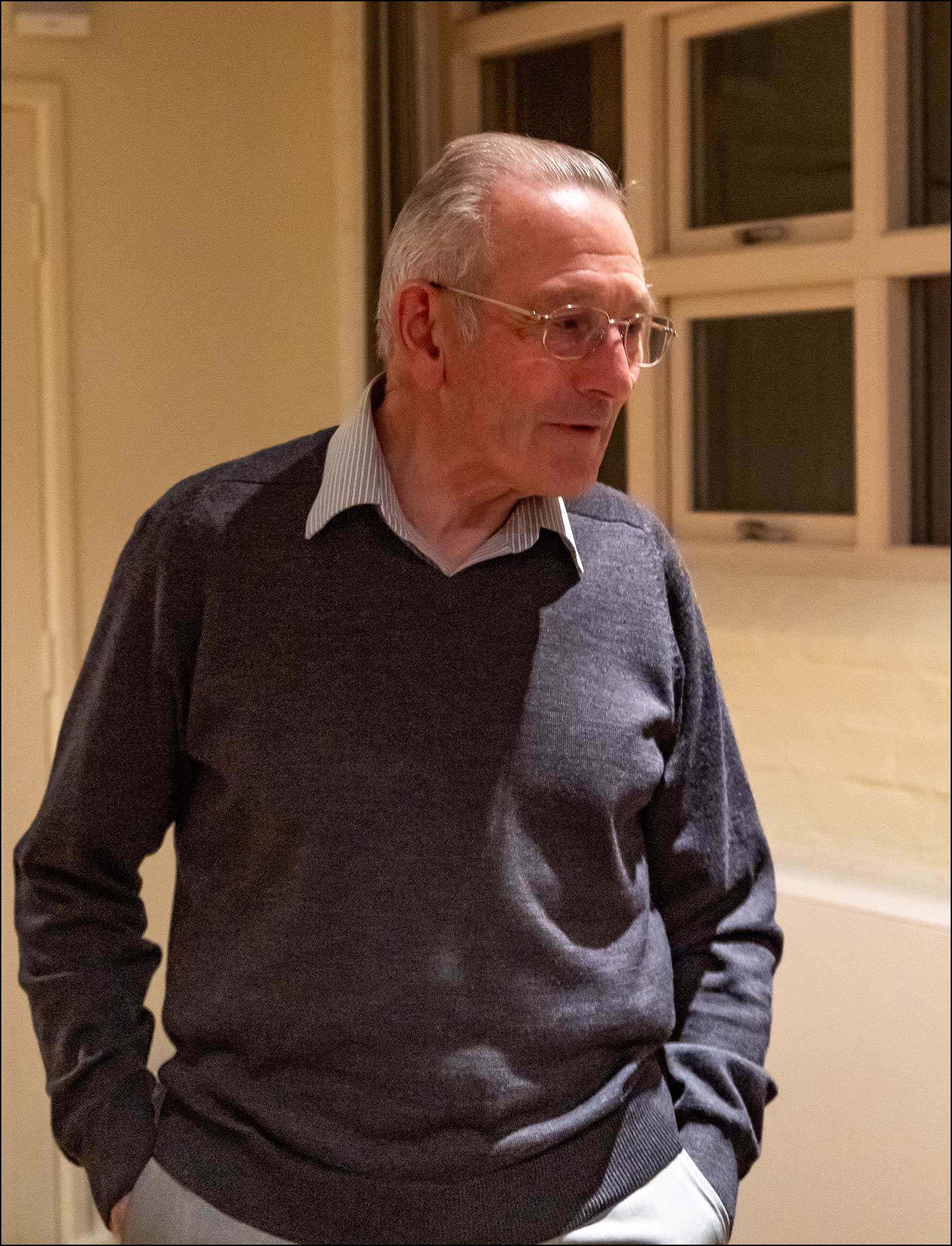
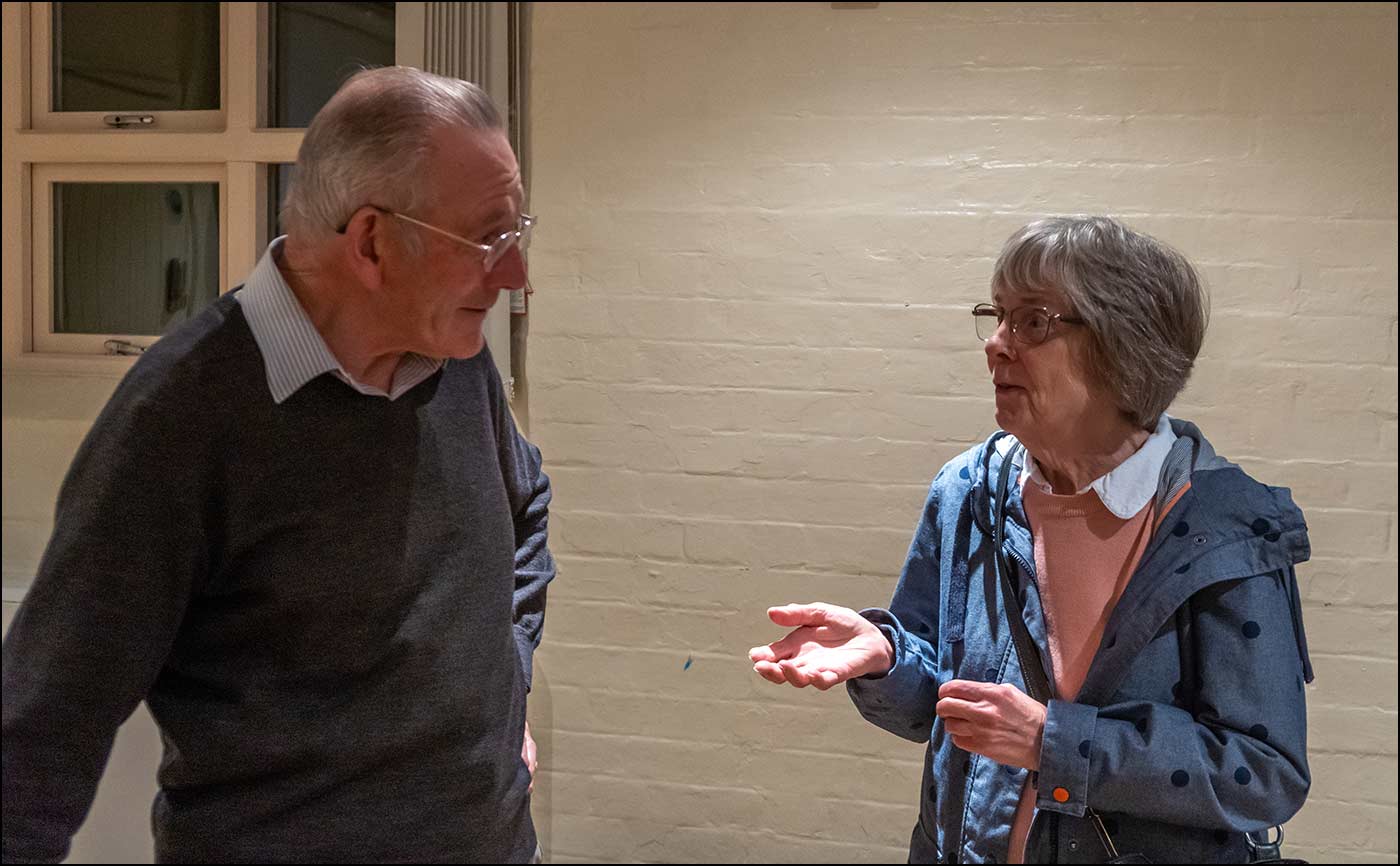




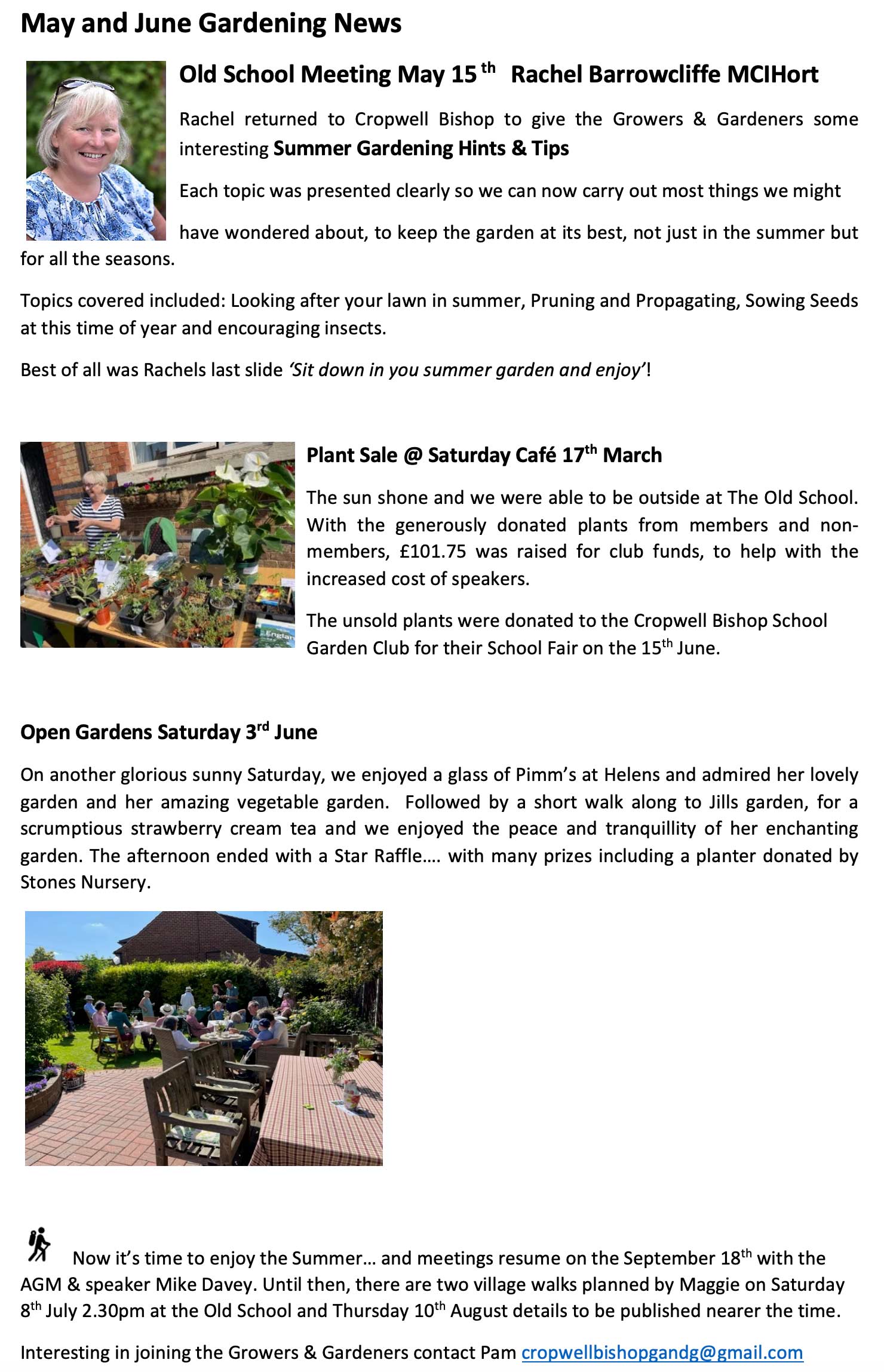



The February meeting was packed out and we gave a warm welcome to a record-breaking number of visitors.
Brian Richardson joined us from Kinoulton bringing along his glorious hellebores for sale. There were recycled garden magazines to buy – 30p. magazines and plenty of donated seeds to choose from on the seed stall.
We are very grateful for the generous seed donations and raffle prize we have received. along with the Gardening Magazines.
Something new for next month’ Pot posies’ a selection should be available in March to brighten up your windowsill.

‘Cyclamen in the Wild and Cultivation’ presented by David Charlton 20th February.
The Hall was in full bloom for this event with Hellebores of all shades available for sale at one side and a table of different types of the low growing spreading cyclamen on the other.
David then gave a wonderful tour of the world of this popular, often taken for granted, little plant. His beautiful slides were taken in places from the Eastern Mediterranean to New England for examples of wild cyclamen, to the show benches of RHS Harlow Carr where David has won prizes for the cultivated plants he had nurtured to perfection.
We heard how cyclamen of one type or another will be flowering for most of the year (Apart from June).
This little plant can survive under trees, will tolerate dry conditions and likes well drained soil and has an infinite variety of leaf patterns and shapes.
It Self-seeds in unusual places appearing between paving slabs and in rockeries, courtesy of the ants distributing the seeds.
In the UK the Hederifolium variety flowers in the autumn and the Coum variety will be flowering now, carpeting the ground along with the snowdrops.
Brian gave us some useful tips on cultivating the Cyclamen including using ‘Tesco Cat Litter’ also recommended by Mike Davey last September for cultivating his succulents.

Next meeting Monday 20th March the Old School 7.30pm.
Visitors welcome £3.50.
We look forward to the return of our favourite speaker Stuart Dixon who captivated us with ‘Clematis Queen of the Climbers’ in 2020, This time he will enthuse us with ‘Dreaming Spires’ hear about Delphiniums, Ermurus, Hollyhocks and many more.

Pam
cropwellbishopgandg@gmail.com
07759 954999
16th January Cascades …
From Jungle to Paradise by Alan Clements.
Many members were present at this very well attended lively evening to hear this wonderful talk.
In contrast to the excitement of the raffle and chatter was the absolute silence during Alan's fascinating and at times emotional account of how he came to create this unique garden in the village of Bonsall near Matlock.

For anyone who wants to visit the garden after hearing the talk, and also anyone who is interested in bonsai, meditation and stunning planting or just resting on the many benches while exploring the views and waterfalls of this steep and rocky garden, it opens at the beginning of March - just in time for spring!
https://cascadesgardens.com/garden/
We also heard from Gerry about the record breaking Keyworth ‘Hedgehog Highway’.

Link your garden.
Ensuring hedgehogs can pass freely through your garden is one of the most important things you can do to help them.
Why do hedgehogs need holes in fences?
Hedgehogs travel around one mile every night through our parks and gardens in their quest to find enough food and a mate. If you have an enclosed garden, you might be getting in the way of their plans.
One of the main reasons hedgehogs are struggling in Britain is because our fences and walls are becoming more and more secure, reducing the amount of land available to them.
We can make their life a little easier by removing the barriers within our control – for example, by making holes in or under our garden fences and walls for them to pass through.
DIY ‘Hedgehog Highways’
13cm by 13cm square is sufficient for any hedgehog to pass through. This will be too small for nearly all pets.

For more information:
https://www.hedgehogstreet.org/help-hedgehogs/link-your-garden/
Next Meeting 20th February @ The Old School 7.30 visitors welcome £3.50:
"Cyclamen in the wild and in cultivation" with David Charlton.
Pam Wregg


One of our favourite speakers Mike Davey returned to the Old School to present to us ‘Plants of the Desert’. Mike has a large collection of Cacti and Succulents inside several greenhouses and outside n his lovely garden too.
His beautiful photographs were certainly an inspiration to anyone thinking of growing cacti and succulents which are proving popular at the moment.
There are many different forms of the plants and we heard how easy they are to care for, requiring a well-drained compost, good light and easy to propagate. Mike suggested adding grit or perlite to your potting compost - 25-50% volume of sharp grit, he joked about people using cat litter too!
With most Garden Centres selling cacti and also available on line, there is a huge selection so there are plenty of opportunities to try your hand at growing these fascinating plants Some of us were fortunate this summer to visit Mikes Garden in Ruddington and see first-hand his plants and sample his wife’s lovely cakes.
Mikes donates his fee + his plant sale proceeds to a Children’s Charity.
Seed Stall
Following a plea for seed donations we held our first ‘Seed Sale’ at our November Meeting.
Thank you to everyone who contributed and will have the seeds available to buy each month from the January Meeting.
Any unwanted seed packets or spare seeds labelled in an envelope would be very welcome.
Christmas Social December 19th The Old School 7.30pm
To end the year a Super Special Raffle and enjoy a glass of mulled wine and a ‘Pot Luck’ Supper with Christmas Carols.
Pam Wregg


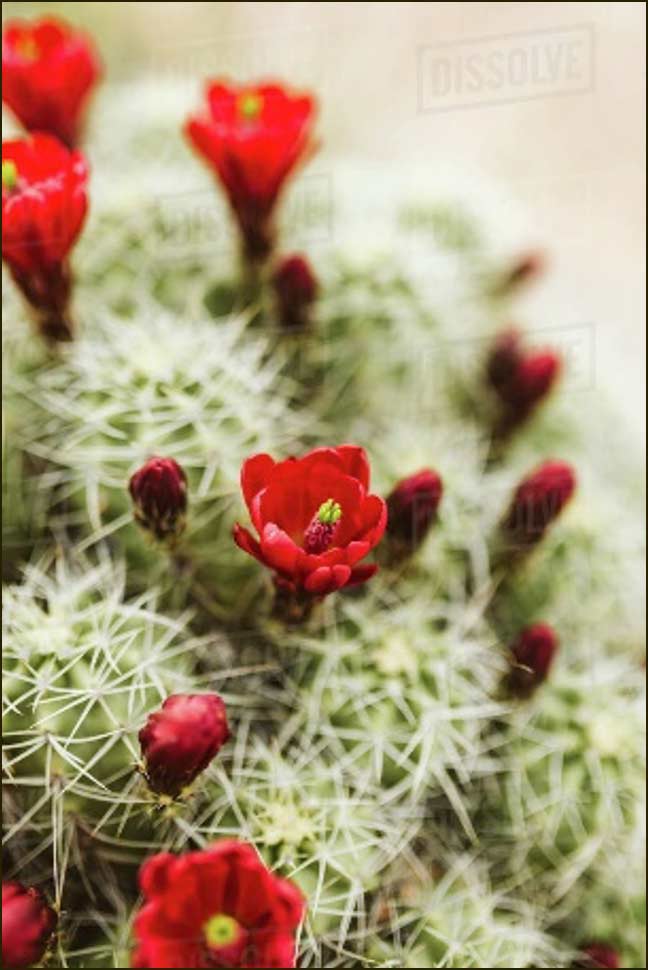

The delayed first meeting for the new Season was held at the Old School 17th October commencing with the AGM.
The offices were re-elected, being Chairman Anne Turner, Treasurer Gerry Humphries and Secretary Pam Wregg supported by Shona Crawford and this year Mark Foss, Maggie Shirren, and Jill Horton.
AGM Update will be in the in the Club November Newsletter.
Hollyhock seeds will still be available at the next meeting in November.
Following the AGM Janete Merilion (a BBC presenter and garden designer) presented an entertaining and informative talk ‘Tints of Autumn - very topical for the time of year.
She was very knowledgeable with plenty of unusual suggestions for plants, shrubs and trees to use in the garden to give a good show of colour at this time of year.
These are just a few of my favourites from last night.
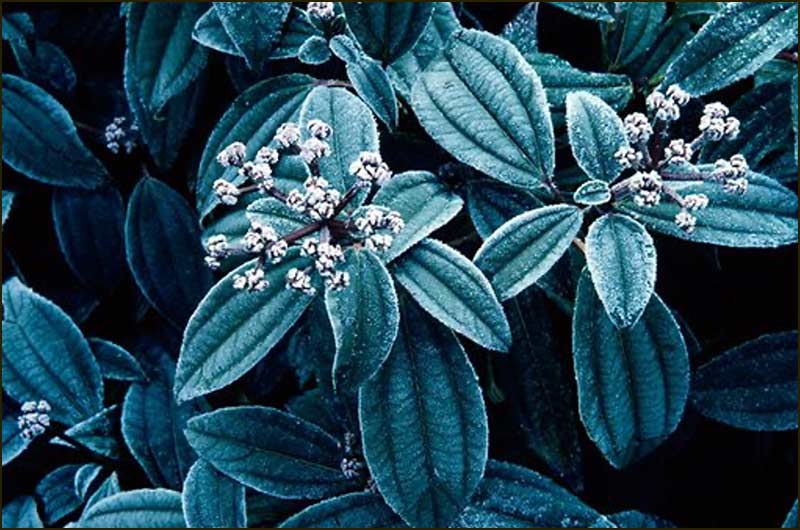
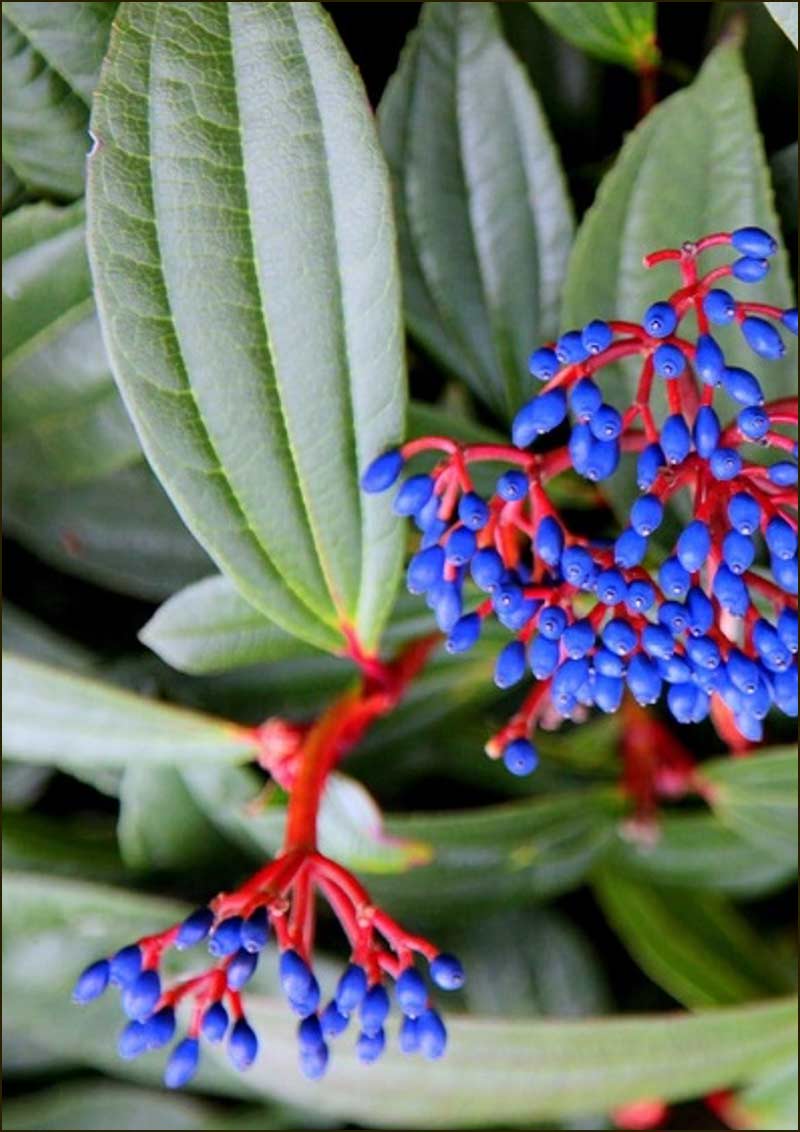

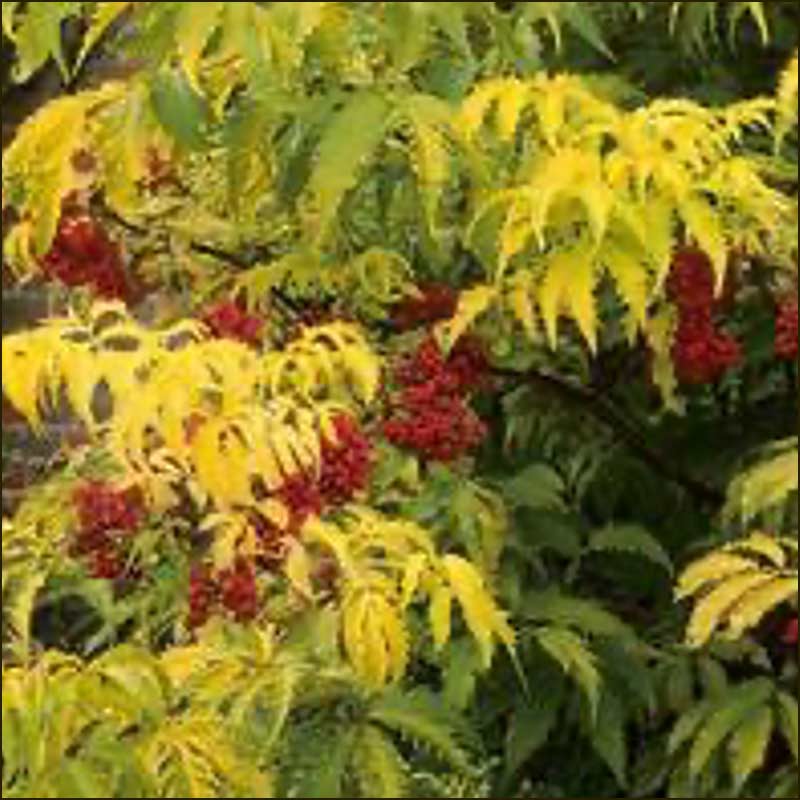

Next Meeting:
November 21st with the return of Mike Davey ‘Plants of the Desert’ – looking forward to hearing what plants will survive in our gardens if anything like this summer happens again!
Saturday 22nd October – WALK 8
Fern Field Walk meet @ The Old School 2.30pm 3 miles approx. 1 hr.
https://cropwellbishopplan.co.uk/walk-FernField.html
Pam Wregg
Following the recent announcement of the State Funeral for Her Majesty Queen Elizabeth II on Monday 19th September, the Old School will be closed for the day and our Meeting is cancelled.
Our heartfelt condolences are with the Royal Family at this sad time.
With the Old School fully booked from next week, our AGM will now be held on the 17th October, at our next meeting 'Tints of Autumn’ and Mike Davey will be returning for the November Meeting.
In the meantime, the walk Saturday 17th will go ahead, to give members a chance to reflect on the great life of Her Majesty The Queen.
The Blue Hill Walk (approx. 3 miles) meeting at the Old School 2.30pm https://cropwellbishopplan.co.uk/walk-BlueHill.html
Pam Wregg
You can save time renewing your membership of 'Growers and Gardeners' by downloading an application form.
Click on; Membership Form for 2022/23. This pdf can then be printed.
Pam Wregg
Ruddington Garden Visit ...
It was on one of the hottest evenings this year.
We were lucky to enjoy the cool tranquillity of Mike’s Garden with a mature tree canopy, numerous ponds and some imaginative planting.
Linda gave us a delightful ‘English Garden Tea' with a choice of homemade cakes and beautifully laid tables.
Village walk Sunday 21st August ...
Perfect weather for a Sunday morning walk and some walkers were surprised to see the site of the old Cropwell Butler Cricket Ground (early C20th), so close to the village and so flat!
We didn’t have time to investigate the site of the Old Pavilion.
NEW SEASON:
Monday 19th September 7.30pm @ The Old School & AGM Mike Davey returns to share his knowledge and recommends growing succulents, perfect for hot dry summers.
Renew your membership …
check out the September newsletter … will be coming out soon to members and joining details will be on this page next month, membership fee still only £15 a year. For more details cropwellbishopgandg@gmail.com
Visitors welcome £3.50 inc tea & coffee
Pam Wregg


On Saturday afternoon the Growers & Gardeners and their guests celebrated the start of Summer and enjoyed a glass of Pimms and a cream tea at the Old School, with some trying their hand at croquet in the lovely garden.
The Old School Monday meetings will recommence with the AGM on the 19th September with the return of Mike Davey sharing his knowledge of the benefits of growing succulents.
In the meantime we will shortly be announcing arrangements for some local summer walks in our the July newsletter and on this page.
Happy hoeing!
Pam Wregg
(Thanks to Mel for the photographs)




Who loves wasps? No one? Well Dr Ian Bedford and his colleagues at John Innes – where he used to be a Head of Department – think we should reconsider our decision.
They are all entomologists – they study insects.
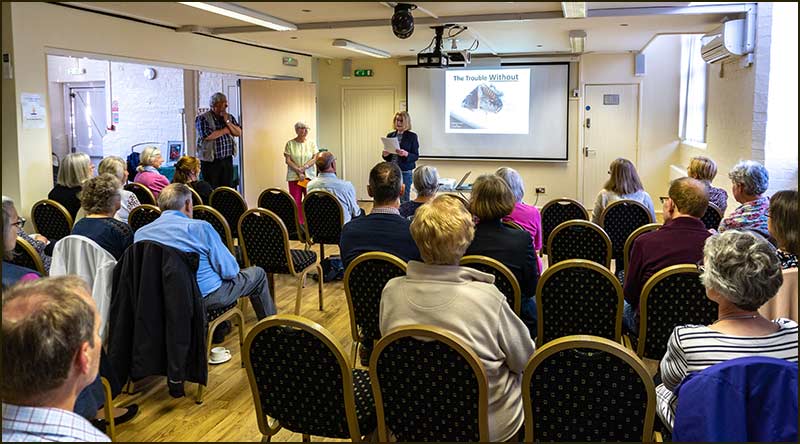
At the Garden Club’s meeting at The Old School last night, Ian described the history, range and habits of wasps.
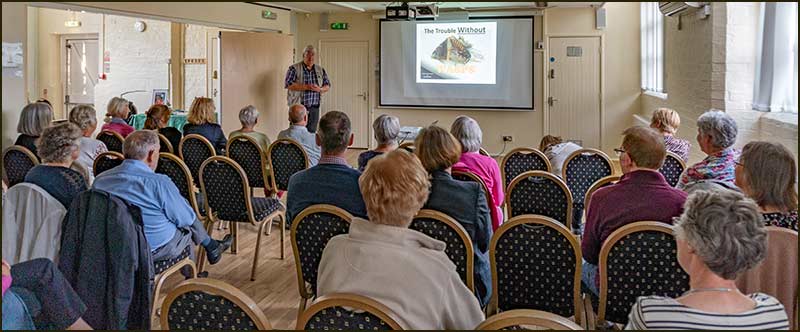
It turns out that the stinging wasps that we all fear and curse, are just one kind of the hundreds of thousands of varieties that exist in nature.
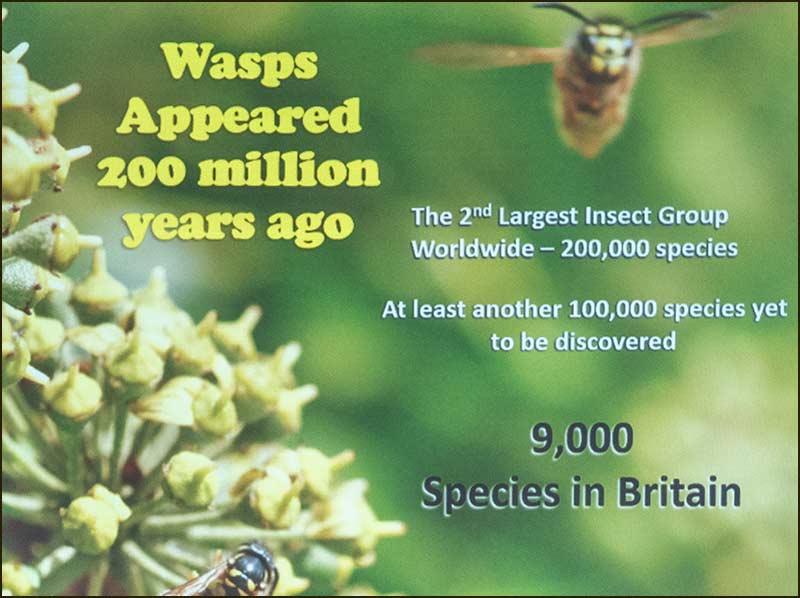
Most are solitary that live and nest in much the same way as birds do: they do not live together on one big nest – they raise a little family in isolation. Although, unlike birds, they are likely to lay their eggs inside the body of some caterpillar or aphid.

This gives the developing baby wasp a ready supply of fresh food, which is not good news for the caterpillar is eaten alive.
Although, in the case of an aphid on your cabbages, a wasp that eats them alive before they get the chance to eat your cabbage leaves, is good news.
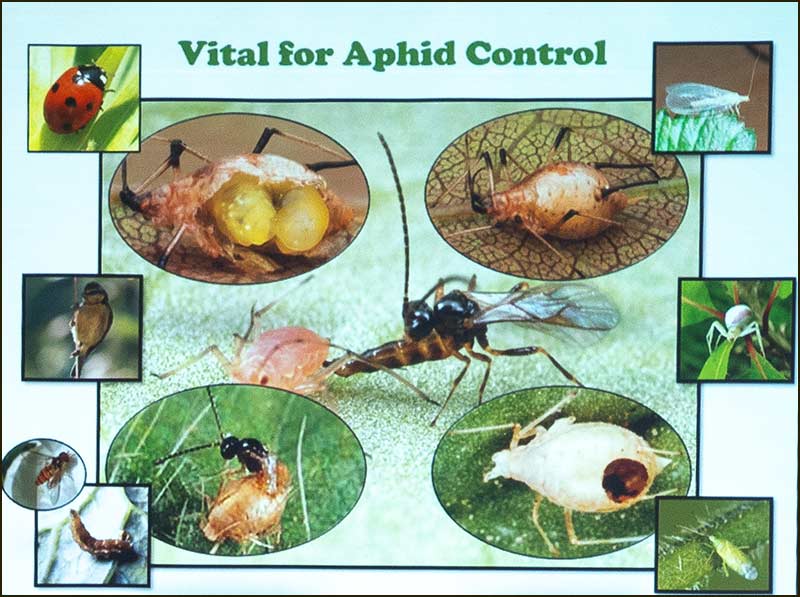
This is an example of the point that Ian Bedford constantly returned to: if we encourage the right insects in the right places, we can protect the plants we want to flourish without the need for harmful (and expensive) insecticides.
I am sure that the people who were at the meeting – both members and guests – will now look at wasps in a different light.
Yes, some female wasps will give you a painful sting which we all should avoid but, if they don't look upon you as a home for their eggs (and, thankfully, they don't see humans as such), then a sting is simply their form of defence.
So, if we don't offend them, they won't sting us (in general).
One fascinating discovery by Ian and his colleagues, was that because wasps avoid birds (birds eat wasps), if you "impersonate" a bird then they will fly away.
This is easier than it sounds! You just need to curve your hand, hold it up and paw it forward in a jerky, quick motion. This wasp thinks your hand is a bird and speeds away. It sounds like a joke, but Ian assured us it works.
They even gave this ploy a name: the Norfolk Jasper Jab.
Tony Jarrow

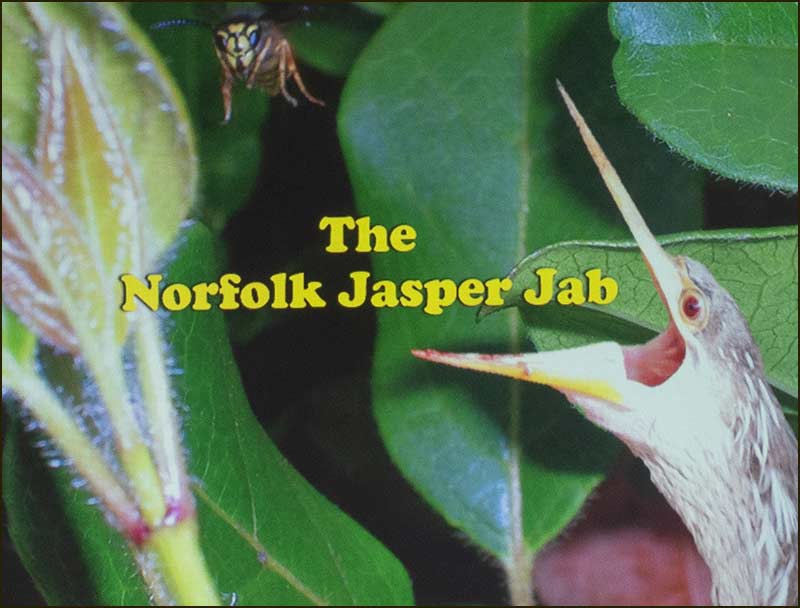
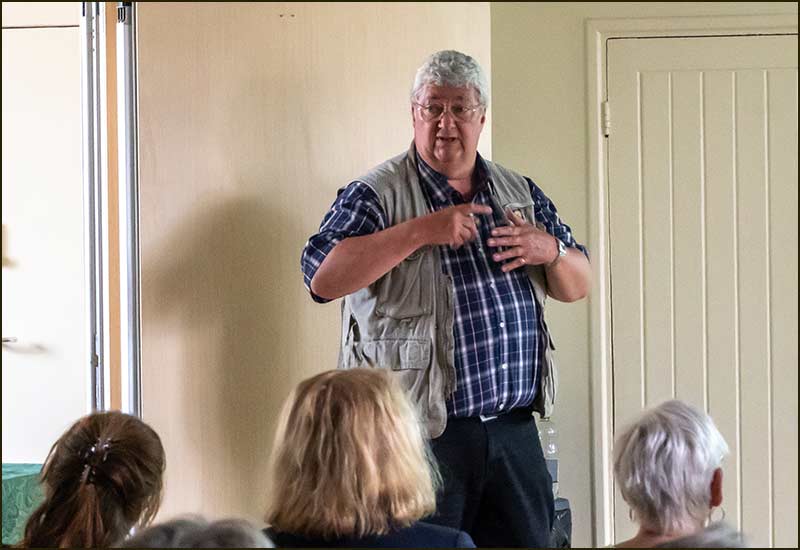






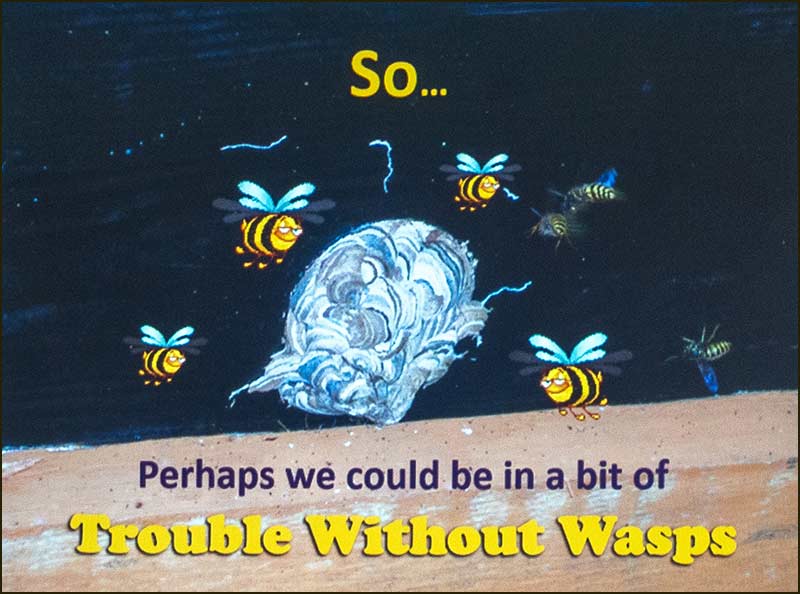
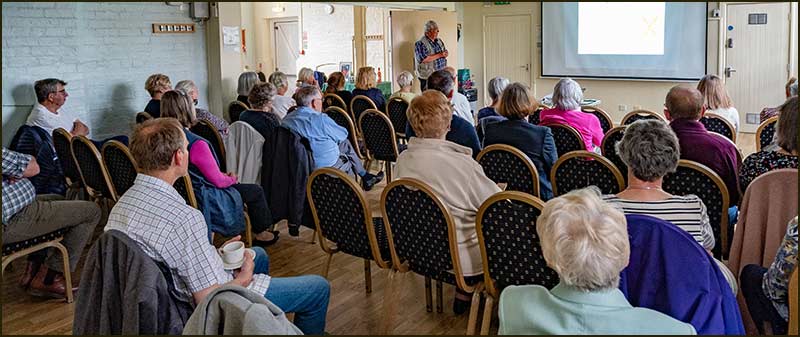
We were lucky with our visit to Holme Pierrpont Hall gardens, on a gloriously sunny evening.
Walking through the historic Tudor gardens, with beautiful planting and enjoying some entertaining anecdotes from the owner Richard Brackenbury.
Holme Pierrepont Hall is the family home of the Brackenbury family, who are direct descendants of the Pierrepont Family who have lived on this site since 1280.
Holme Pierrpont will be hosting an outside production of Midsummer Night’s Dream, Performed by The Festival Players on Thursday 9th June @7.30 Pre booking required see:
www.holmepeirrponthall.com/events.html
Pam Wregg
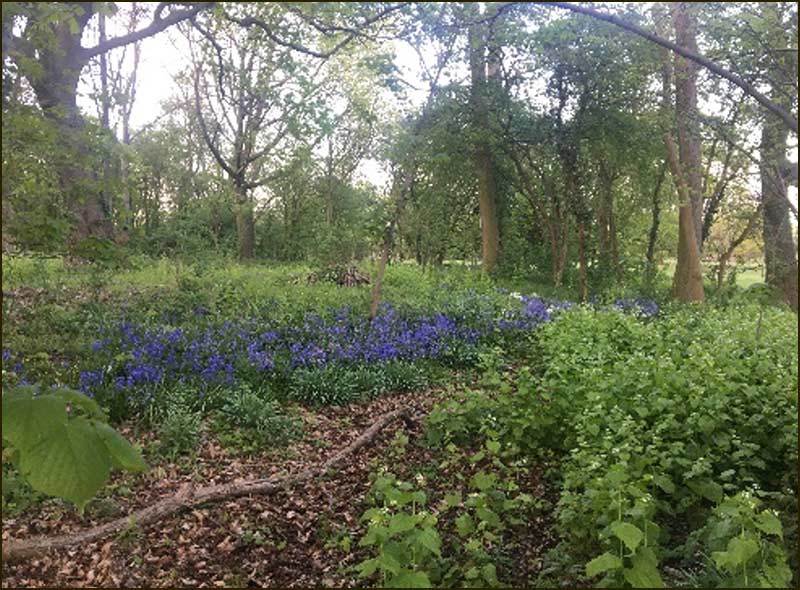


The day for clearing up and planting turned out to be a lovely sunny Sunday Morning at the Lower Hoe View Green.
The area was transformed into a natural wildlife area including a bug’s home for insects to feed the pollinators.
Thank you to the Parish Council for organising and to our members who donated plants and their time.
Will be interesting to follow the progress of this special area, so beloved by the village children.
Pam Wregg

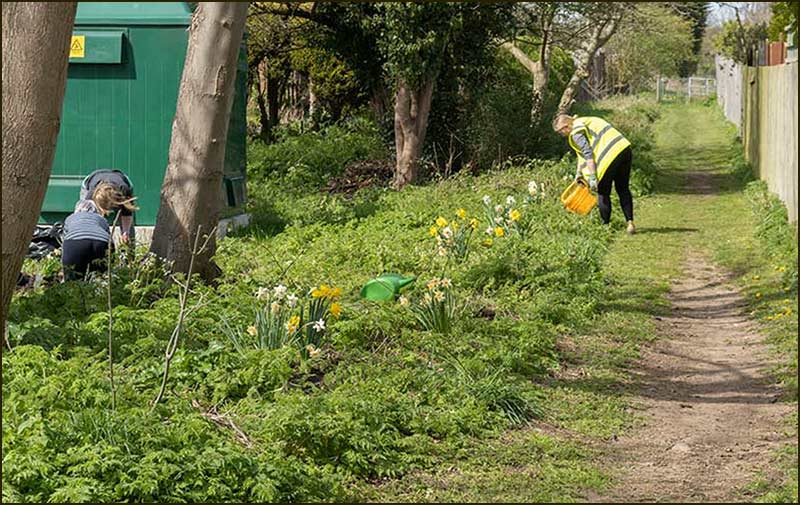
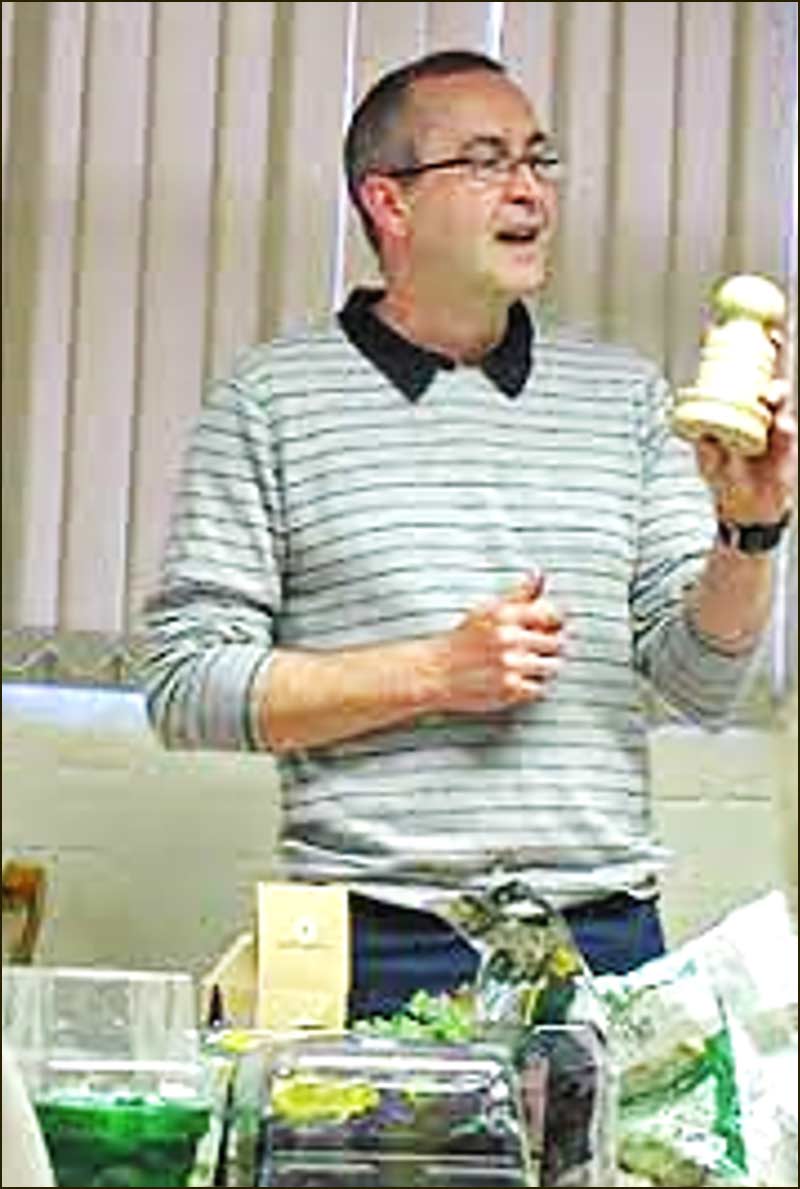
On a warm sunny evening, Geoff Hodge returned to the village to give us some entertaining and interesting ideas about ‘Low maintenance - Easy Gardening’.
Preventing injuries was top of his list, especially repetitive strain and back injuries.
Geoff went through some of the new whizzy kit available for Gardeners, including various new watering gadgets one of them a being a programmable watering computer to attach to your outside tap. We all gasped at a menacing pair of shears Geoff demonstrated.
The tip all of us I am sure will remember was to encourage us to sharpen our sectators…… and our hoes!
Pam Wregg
The first Meeting of the season was held on the 17th September with our AGM followed by a talk, 'Allotment Gardening - Vegetables for all Seasons', presented by a familiar and popular speaker, Mike Davey.
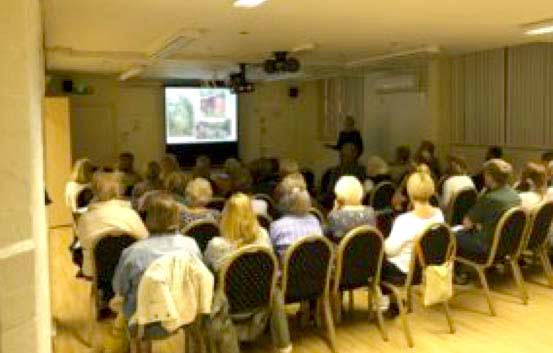
Mike's talk was packed full of useful information and there was something for all types of Gardeners, including a lively question and answer session during the evening.
Here are our Top 10 Hints & Tips from Mike's talk
1. Buy your seeds in bulk and split them up
2. Make your own compost bin
3. Use blue water pipe to make your own cloche
4. Plant and dig in green manure
5. After cropping dig your bean & pea plants into beds to add nitrogen to the soil
6. Cover carrots and parsnip with fleece to stop greenfly
7. Leave nettles around compost bins for a quick and easy boost
8. Buy your potatoes the first week in January
9. Watch out for problem resistant seeds - problems still occur
10. Don’t leave your shed unattended - it may go!
2018 Meetings:
October 15th
Spring Planting - 'Bulbs and Lasagne planting': a talk by Rachel Barrowcliffe
November 19th
'World of Ferns': a talk by Neil Timm. Ferns will be available to buy during the evening.
December 17th
Christmas Social: Pot Luck Supper with Carols and Songs from the Cropwell Bishop singers. Raffle.
Meetings are held the 3rd Monday of the month 7.30pm at The Old School.
Membership is £15 and visitors are welcome at £3 on the evening.
For more information:
www.cropwellbishopgrowersandgardeners.co.uk
Email:
contact@cropwellbishopgrowersandgardeners.co.uk
Tel: Secretary Pam Wregg, 0775 9954999
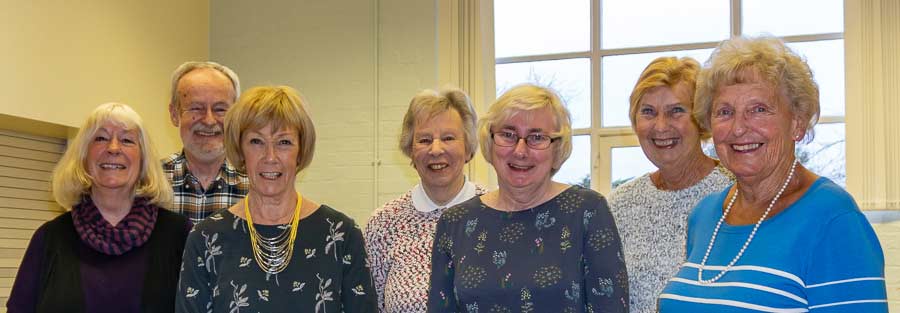
Can it really be 10 years since Cropwell Bishop Gardening Club was set up?
Well, last night at the Old School the evidence was in view, clear and bright on the big screen. Younger versions of the many members could be seen smiling in gardens and at talks, maybe searching for inspiration for their own back garden or maybe just enjoying a good day out.
The evening was a chance for everyone to reminisce and to celebrate all those times.
Judy Thomas had put together several slide shows and Shona Crawford helped her to display them to the appreciative current members.
Glasses of wine, Cropwell Bishop Cheeses and biscuits and 'anniversary cake' encouraged a relaxed and cheerful mood. So did the news that several people were stepping forward to assist Shona Crawford form a new committee for a 2018+ version of the Gardening Club.
This could take months of planning, but at least there is optimism that the Club will go on into 2019.
The photo above is of the current committee: at least half of them were at that first meeting in the Memorial Hall on 21st April 2010 (first photo below).
Others photos show the special cakes, Judy and Glyn, and members enjoying the evening. Judy has led the Gardening Club for all of the last 10 years.
Tony Jarrow

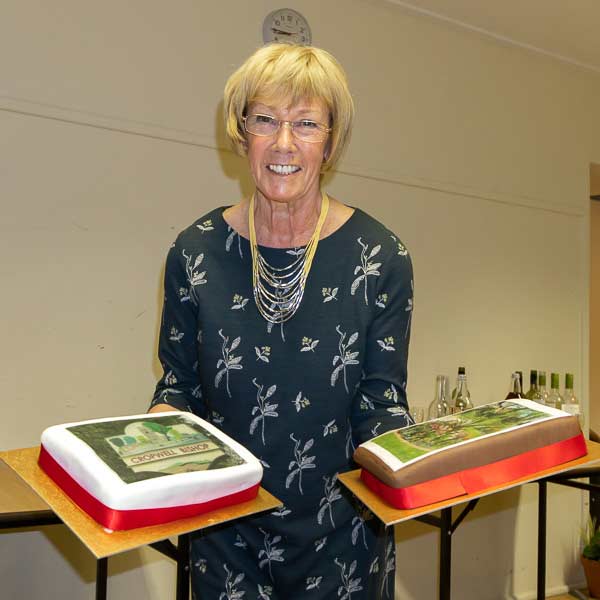

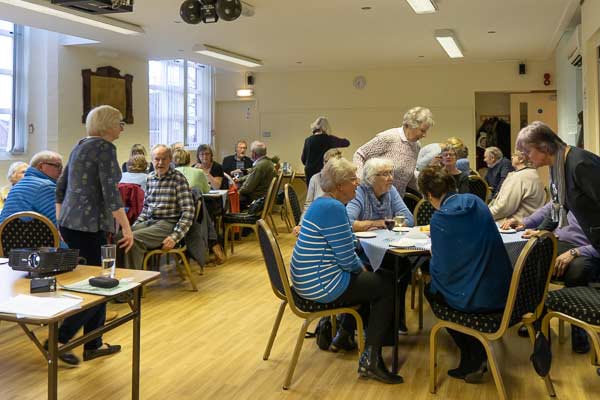
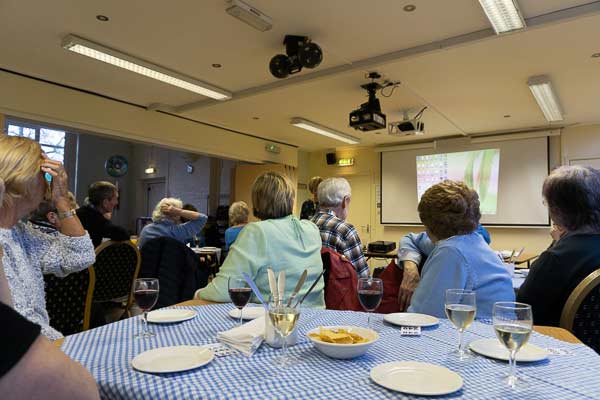
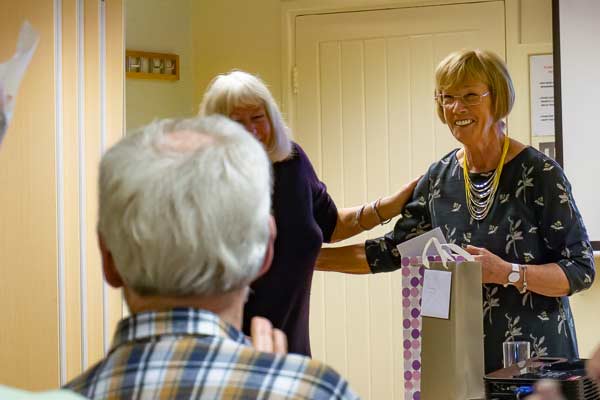
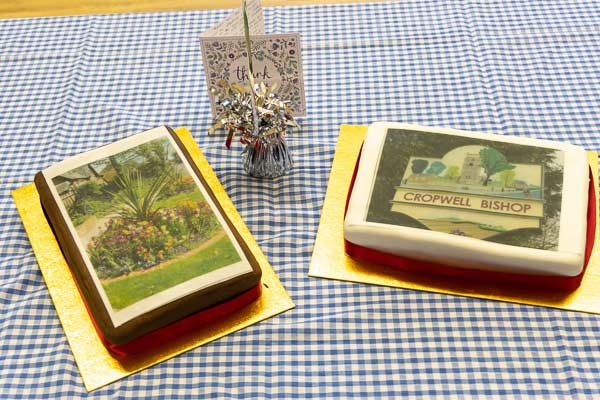
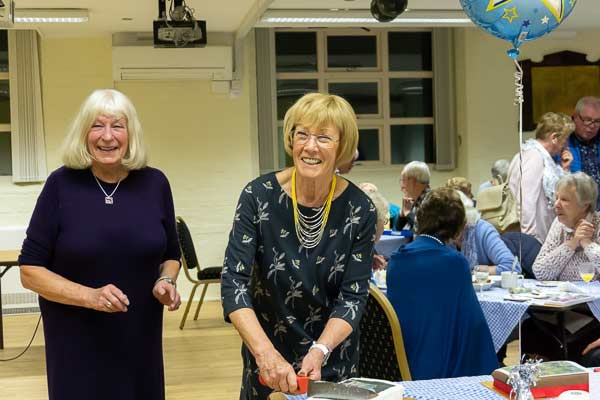
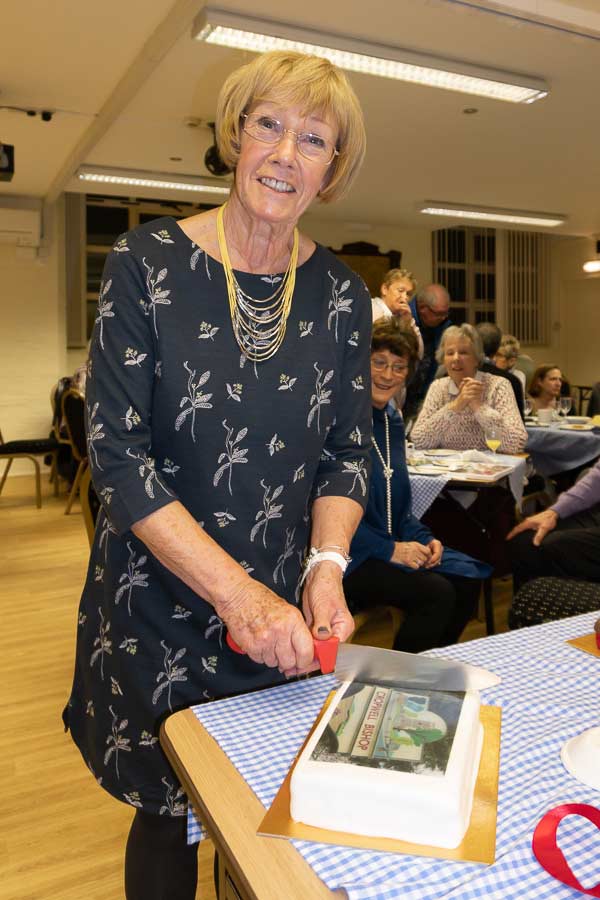
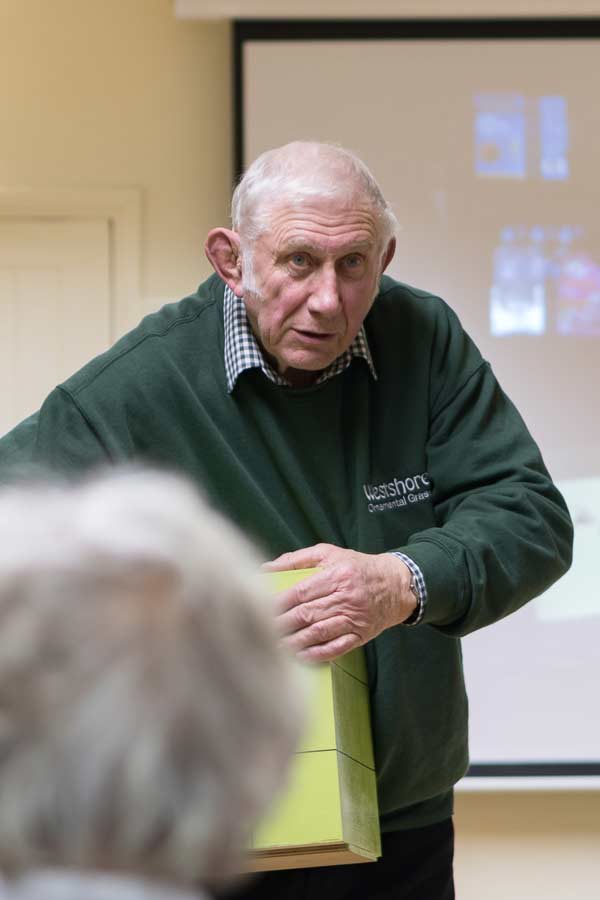
Not everyone has a big garden with lots of flower beds, trees and a sweeping lawn for cricket matches and trampolines. Some people have just a yard and no soil at all. So what can they do?
Answers were to be found at this evening's Cropwell Bishop Gardening Club at the Old School.
John and Gail Summerfield have a gardening business just this side of the Humber Bridge and were here with their props, photographs and stories to show us what is possible.
Years ago, we might have referred to 'container gardening' but now the term is 'micro gardening' and the ideas, technology and approaches have grown a great deal in the meantime.
Not only does the shape, size and colour of containers have to be considered, but also the arrangement of the containers themselves. With careful planning you can create an outdoor living space oozing with colour, character and charm.
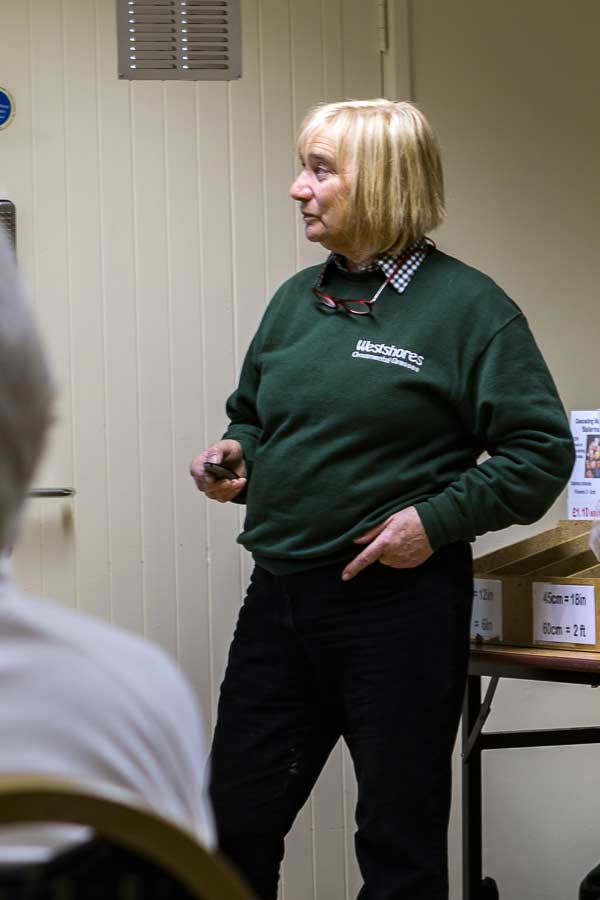
Why not have two or even several plants in the same container—but in doing so you should consider their size, shape and colours to create the most pleasing atmosphere.
As we found out, a micro gardening approach can give our garden, or yard, a new lease of life.
Tony Jarrow

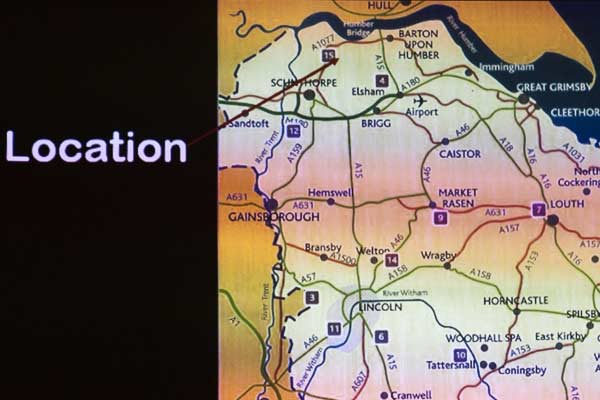
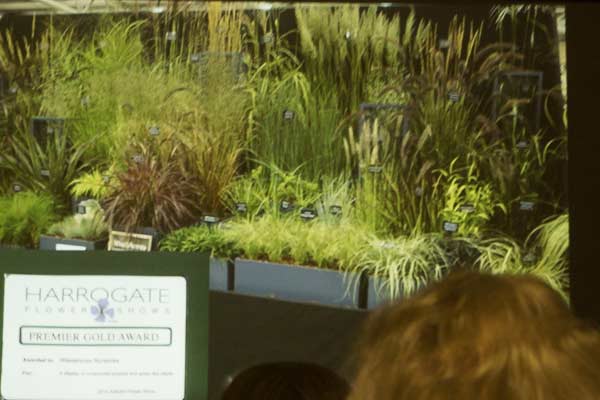

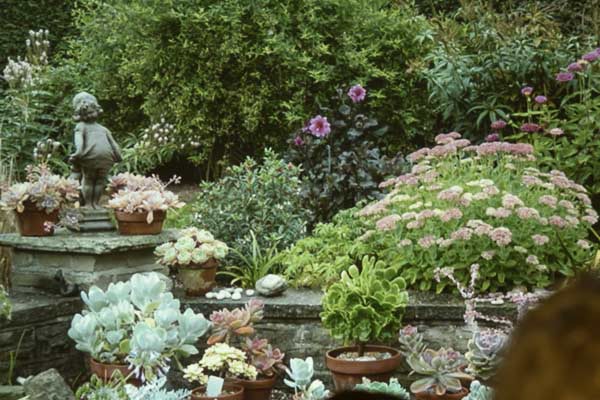
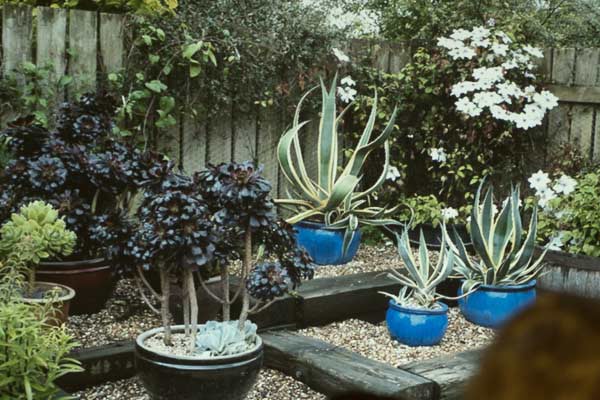
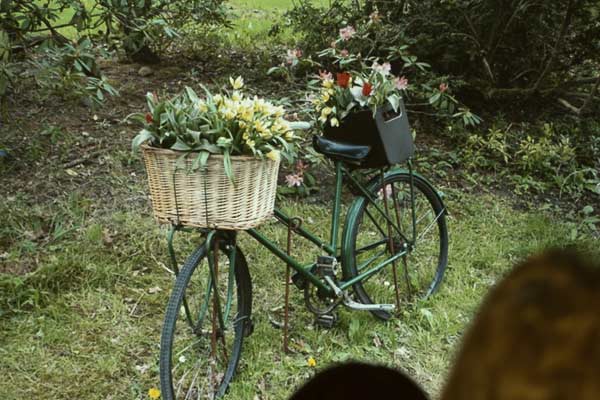

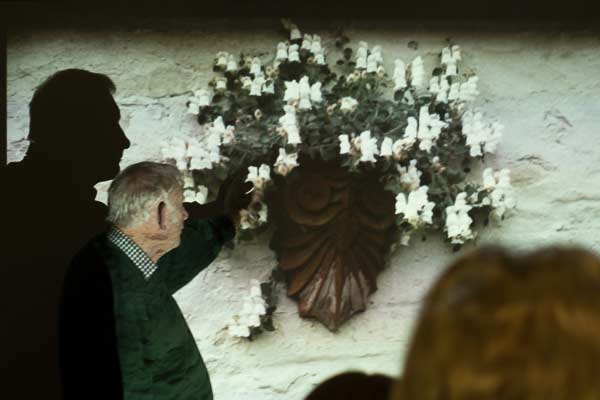

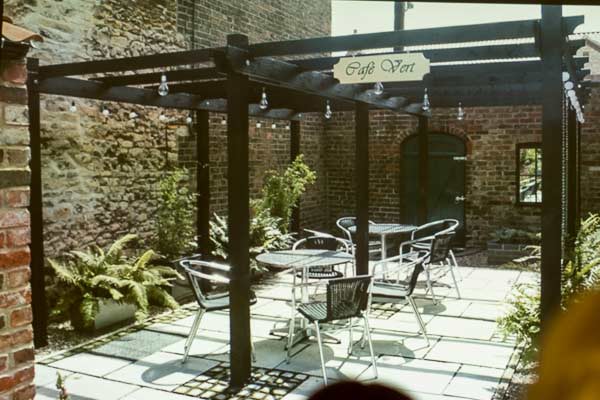
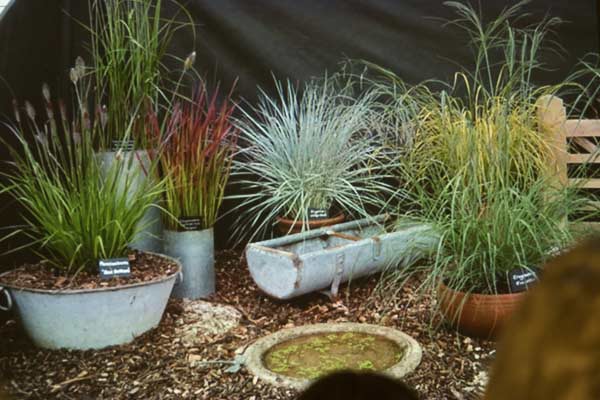
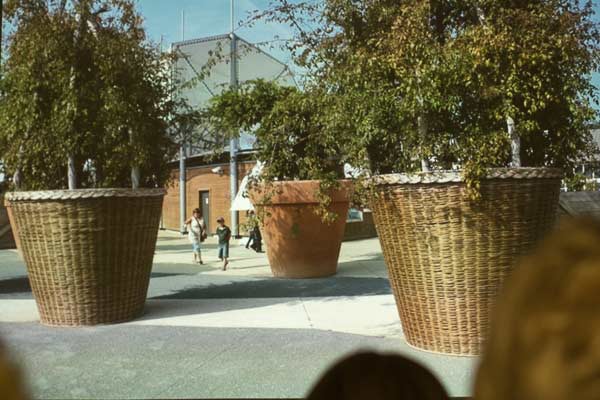
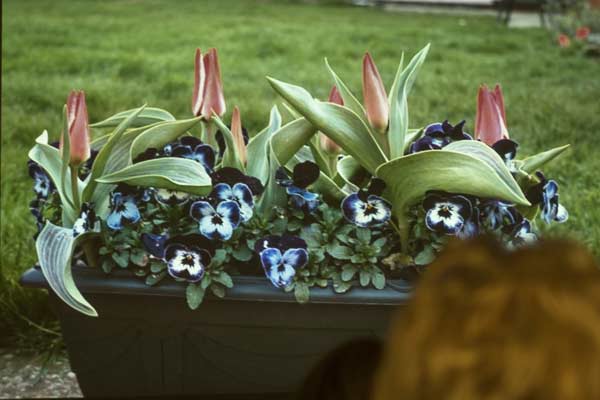


Monday 20th November
Andrew Mikolasjski is a Lecturer by trade and an author by inclination. He has written over 30 books – his latest endeavour acting as consultant contributor to the RHS A-Z of garden plants – a tome of such proportions that it needs its own carrying case!
.jpg)
However, our chosen topic from his extensive repertoire on this evening was the plants and gardens of Elizabethan times and how Shakespeare used them in his writings.
The gardens that Shakespeare inhabited were very different to those of the 21st century. There were limited varieties of plants available – no half-hardy annuals or repeat-flowering roses – and the idea of combination planting was completely alien. So, by the end of July flowering would have ceased and the gardens would be bare until the following spring. But the 17th century was a time of great exploration and the diversity of plants available increased by 20% in Shakespeare’s lifetime.
Gardens came in many shapes and sizes. There were the grand estates of the Royals and their courtiers, the cottage gardens of the peasants where produce was grown for the kitchen and then there were the hedgerows and common lands were medicinal herbs could be gleaned. Also, there were the apothecary gardens where plants and knowledge had been husbanded since the crusaders had arrived back from the holy lands and Arabia over 200 years ago. In Shakespeare’s time there were over 100 Apothecaries in London which then would have been the same size as Leicester. Of course, for the poorer and more rural folk, their medicinal needs were attended to by the village wise woman (or witch) who used common herbs and berries to make their remedies.
Andrew explained that he had been involved in the restoration of Kenilworth castle garden which typifies the Elizabethan approach to horticulture. It seems that in those days conspicuous consumption and luxury were to be flaunted. So it was that Robert Dudley commissioned the quickest garden makeover of the period when he anticipated a 14 day visit by Elizabeth I. Of course, he had an ulterior motive – he wanted to marry her and become even more powerful. The fact that he was already married didn’t seem to signify.
Garden Force eat your heart out because within 3 weeks the area had been transformed. It was laid out according to Islamic principles: an enclosed rectangle divided into four with a central water tank. The space was stuffed with statutory – just like the gardens of the Vatican. In fact, everything was Italianate with an aviary, bowers and beds filled with gillyflowers and edged with miniature strawberries. Even the fruit trees bore fruit – highly unlikely given the season (and in all probability artificial). Anyway, all this expenditure and upheaval was to no avail as it rained every day of her visit, the Queen went home early and Dudley didn’t even plight his troth. You could say it was much ado about nothing!
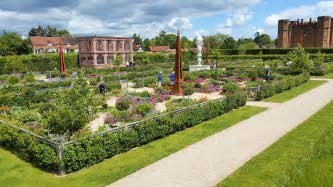
In Shakespearean times there was no cataloguing of plants, no Latin names simply the common vernacular name which was pretty broadly applied. Many plants were grouped together – Shakespeare’s ‘woodbine’ encompassed any climbing plants, including Honeysuckle. No-one seems to know what ‘gilly/jilly’ flowers were – possibly carnations. Gerard’s Herbal was the go-to guide inn 1636 – some say the frontispiece is a portrait of Shakespeare himself. There are many mentions in his plays of the use of plants for good and evil. For example, Melissa/lemon balm used in Macbeth “the sleep balm of hurt minds”. Sea holly thought to be an aphrodisiac used by Falstaff in his efforts to woo. Hemlock was used by the witches in Macbeth. Mandrake appears in Cleopatra, “give me to drink mandragora” and, of course, Rosemary for remembrance as Juliet said “doth not rosemary and Romeo both begin with the same letter!
Andrew’s style of delivery was very theatrical and the extent of his knowledge extraordinary. He certainly held us as spell-bound as the bard himself and gave us food for thought.
Margaret Paul
On Thursday 7th September, 14 members of the Cropwell Bishop Gardening Club visited our own local winemaker at Costock; Eglantine Vineyard. This is what they found there:

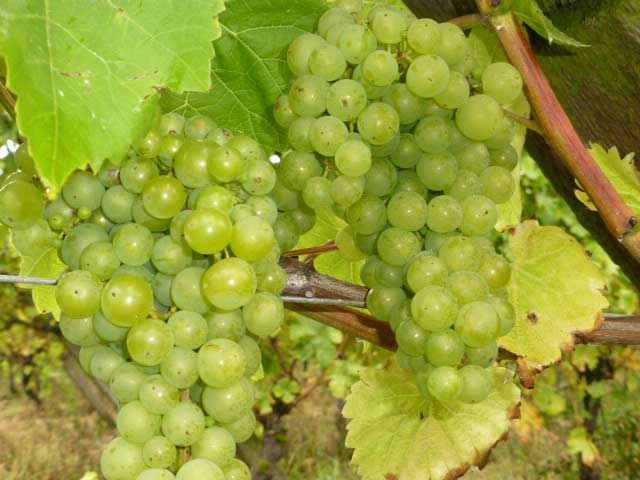


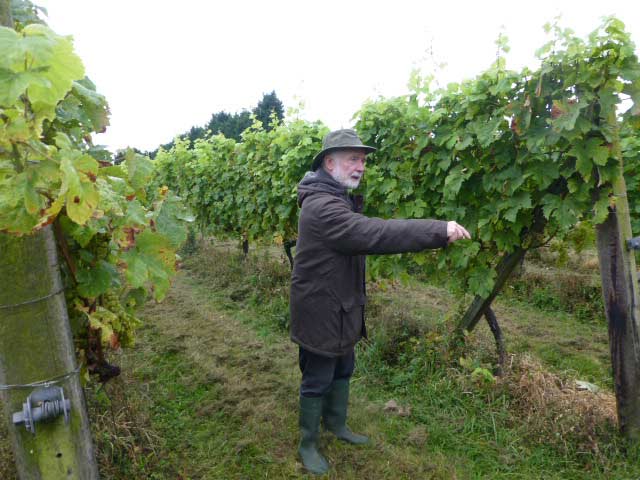
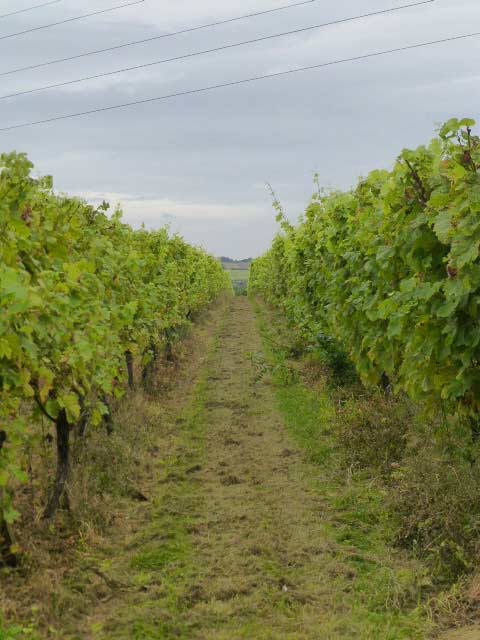

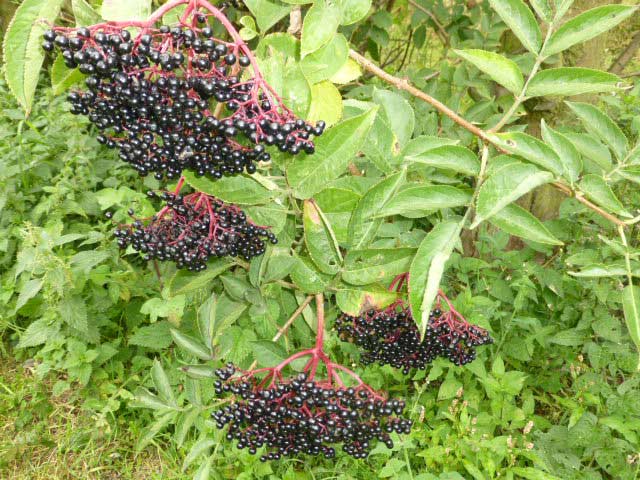


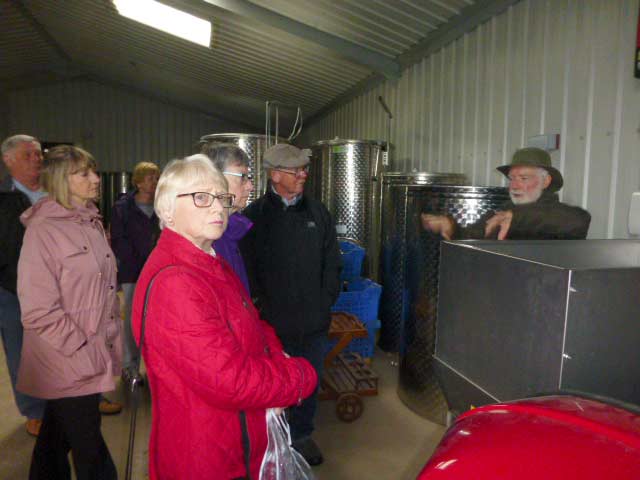

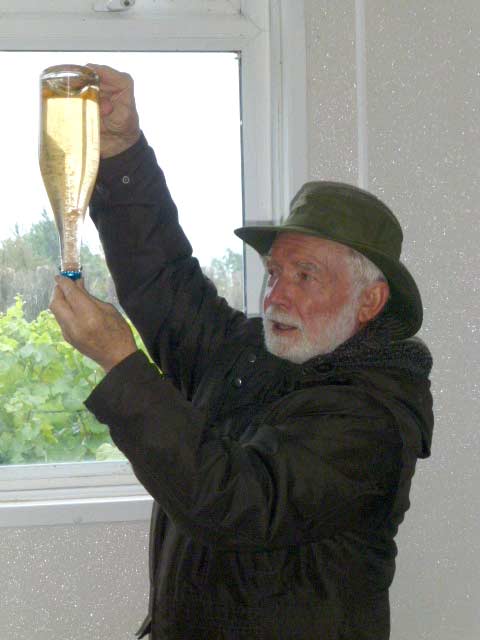
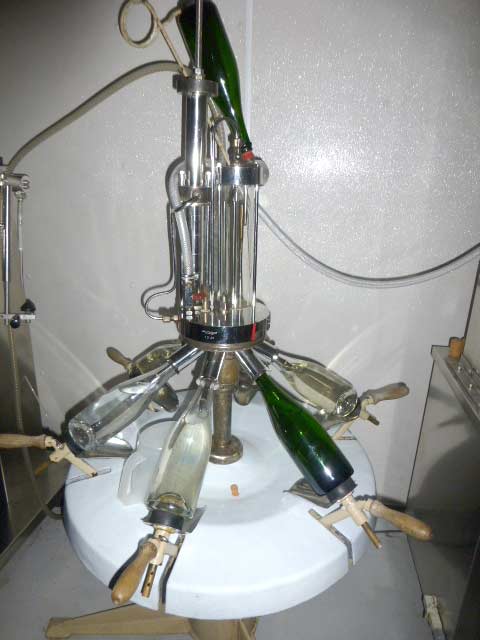

Thursday 22nd June
After a hot, sticky week we were blessed with a perfect evening to visit two contrasting gardens in Keyworth and I expect many of us have driven past both, unaware that two such lovely gardens existed.
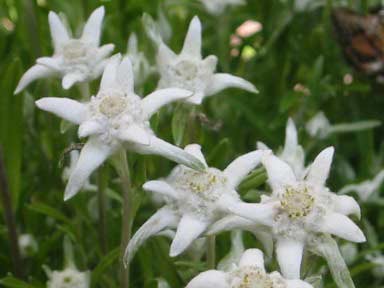
The first garden we visited was “Home Farm House”, the home of Graham and Pippa Tinsley. Graham was born here and his family have lived there for several generations, adding bits of land to the grounds as they became available. Unsurprisingly, it now covers quite a large area containing two ponds, a walled garden, flower borders and mature tress including oak, acers, a bean tree, a magnificent cedar tree which had only been planted as recently as 1983 and had suffered damage from Storm Doris.
The garden itself could be described as “little gardens within a garden” with gaps in the hedges to walk through which led to a rose garden, a well-stocked vegetable patch, soft fruit trees and an orchard. One direction took you under a pergola covered with roses and a vine. After a good look round we sat at tables set out in the garden to enjoy our tea and biscuits.
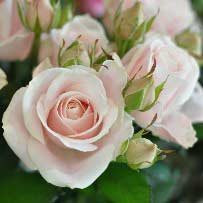
A short drive away was the second garden “Rose Cottage” – home since 1998 of Richard and Julie Fowkes. In complete contrast this was a delightful cottage garden which we were told contained over 500 different varieties of plants – not that anyone was counting.
It was a mass of colour and had two ponds, one with a bog complete with frogs. There was a rockery with a lovely Edelweiss and a potting shed with a sedum roof. Most of us took the time to visit the shed and make purchases from Julie’s art display which contained paintings and cards – many of which were inspired by the garden.
Linda Field
"5 Burton Road,Whatton in the Vale?"
Well the address didn't give too much away did it, what were we to expect? And this was certainly a garden of surprises and delights. To begin with, we were welcomed to the right at the front of the house by two siamese cats in their vegetable garden and greenhouse, and a woodland area to the left. Two areas you might expect at the rear of the house.
Then through an archway of clematis and wisteria to about a quarter of an acre of back garden, but boy, was it a plantsman's paradise.
The general theme was cottaging with quirky paths and stepping stones linking areas of interest at every twist and turn. Colours were linked in shades of purple through soft mauves and blues to the softest pink. I'm not too good at remembering plant names but I know there were lavenders, scabious, agapanthus and verbena bonariensis (I bought one of those, so think I've got the spelling right).
Everywhere you looked there was something of interest and plenty of garden seats and gazebos to stop and stare. There wasn't the smallest space between the planting, with additional plants in containers for good measure and even a green sedum roof garden.
Our thanks to Julia and Martyn for letting us share their garden for an evening and thank you Muriel for all the arrangements. Have a look at all the planting, I'm sure you can name more than me.
Judy Thomas
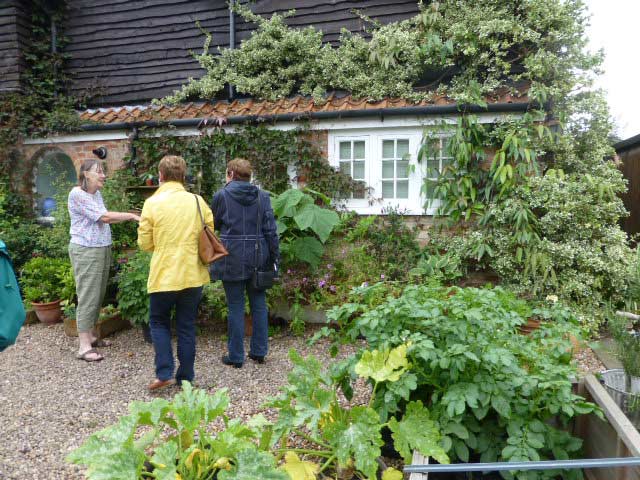


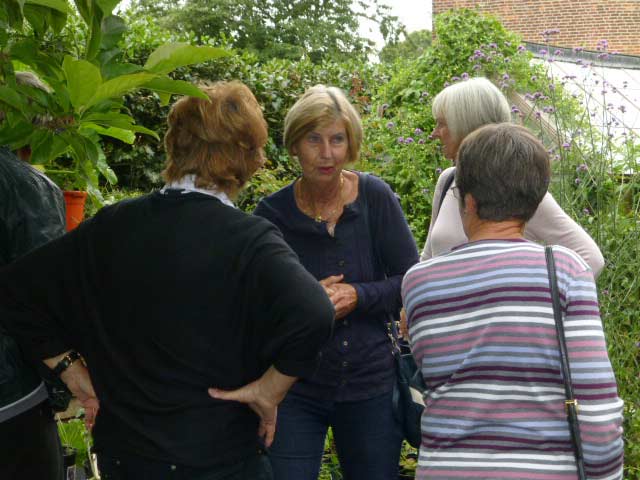

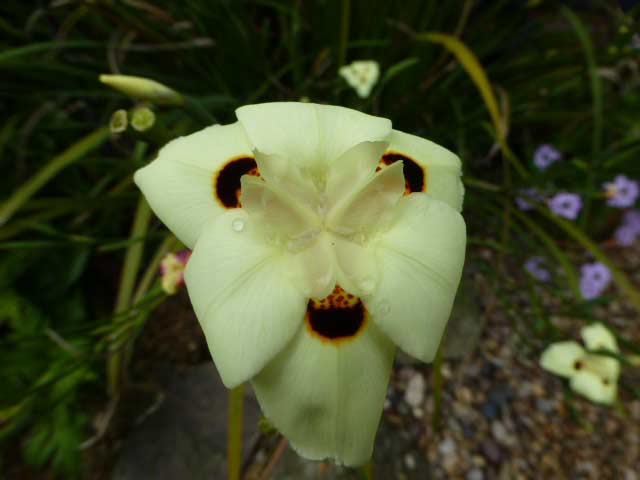
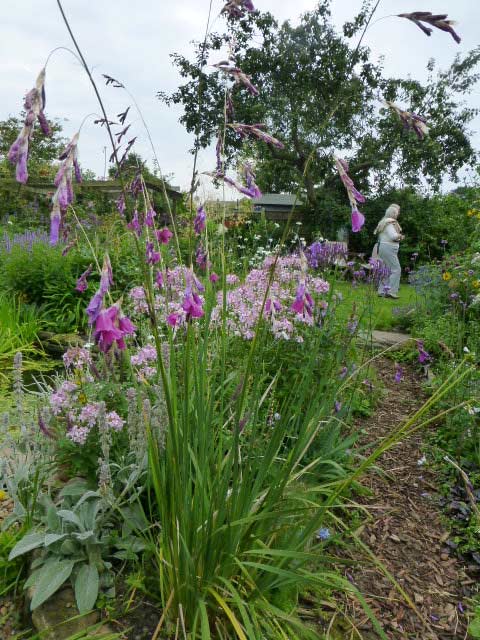

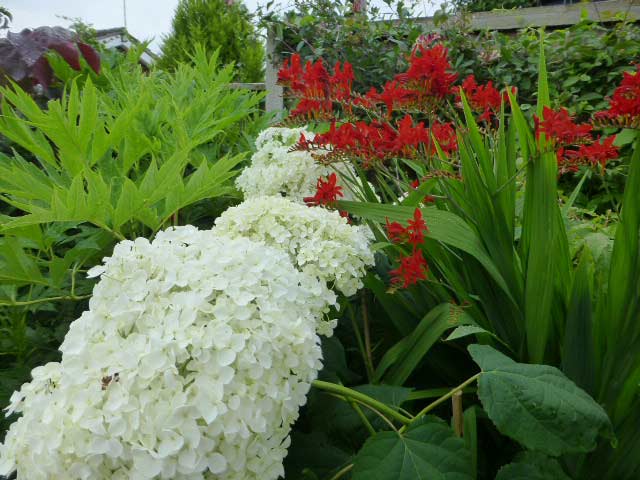

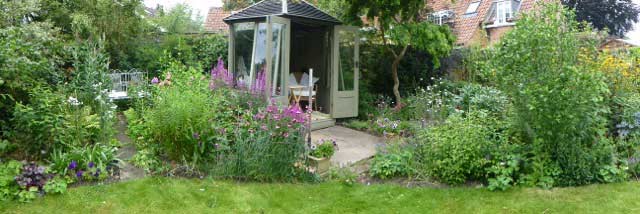
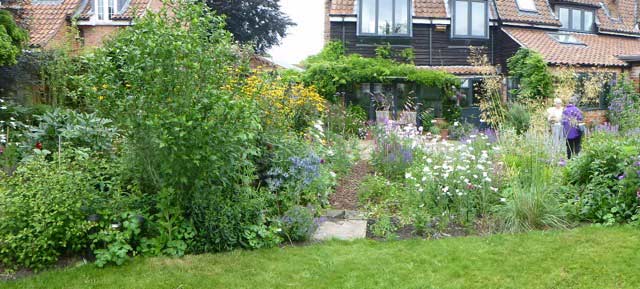
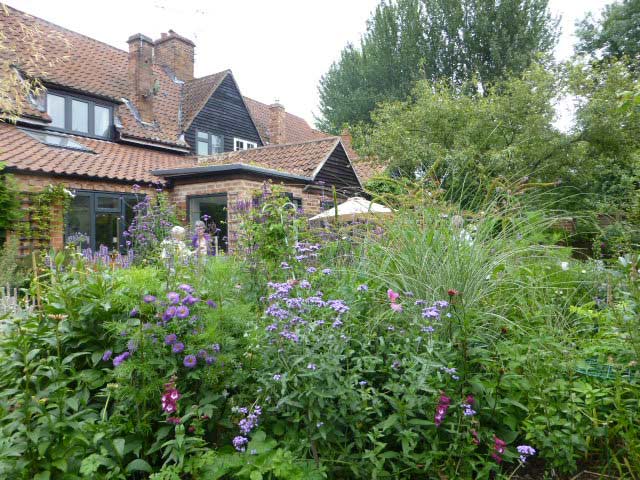
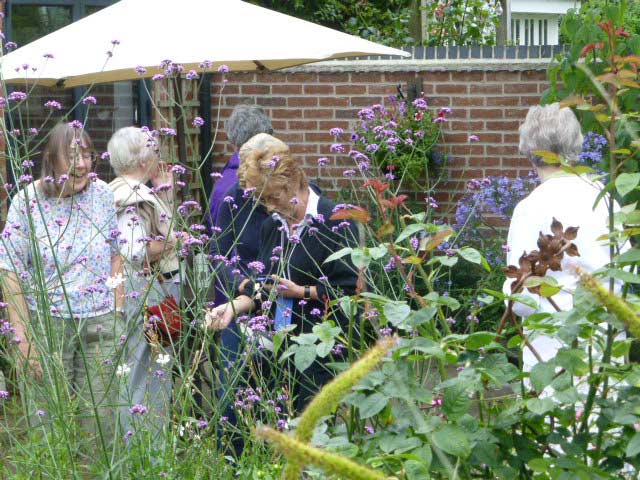
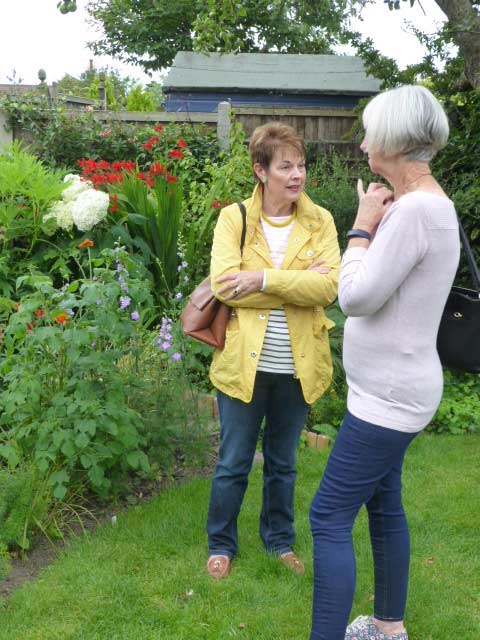
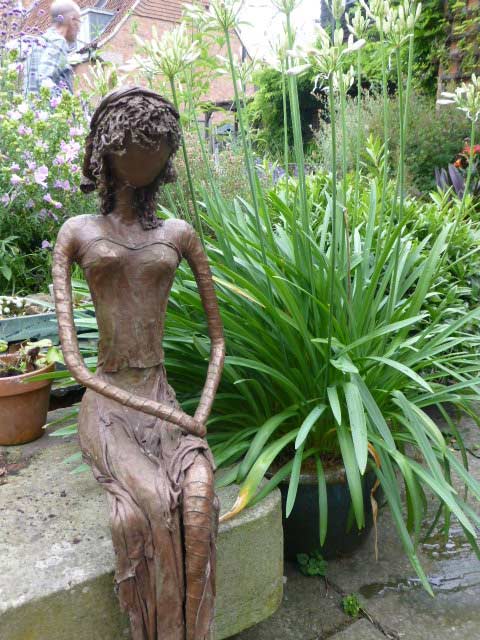

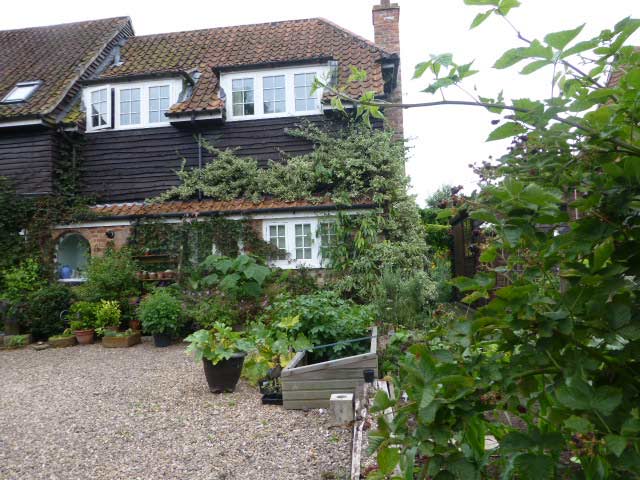
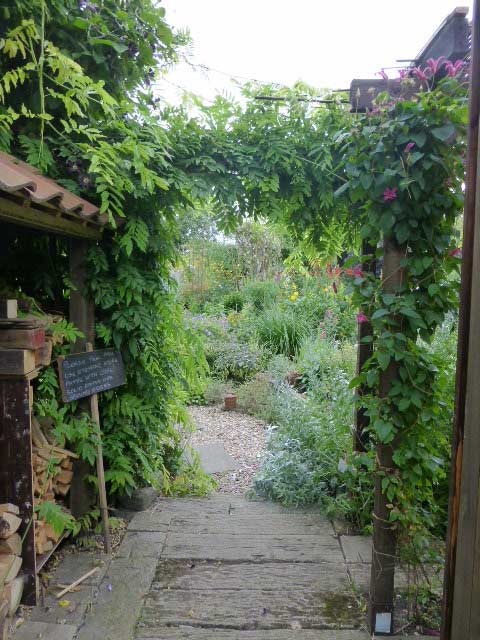
We grow herbs in the back garden so that we can grab a bit to pop in, or on, our food—and that's all there is to herbs.
I appreciate that I have zero skill in the kitchen but I feel sure that I am not alone in thinking that this is all herbs have to offer. However, I now realise that I was very wrong.
The person to put me right was Lynne Tann-Watson. Lynne gave a presentation on Herbs at this evening's meeting of the Cropwell Bishop Gardening Club at the Old School.
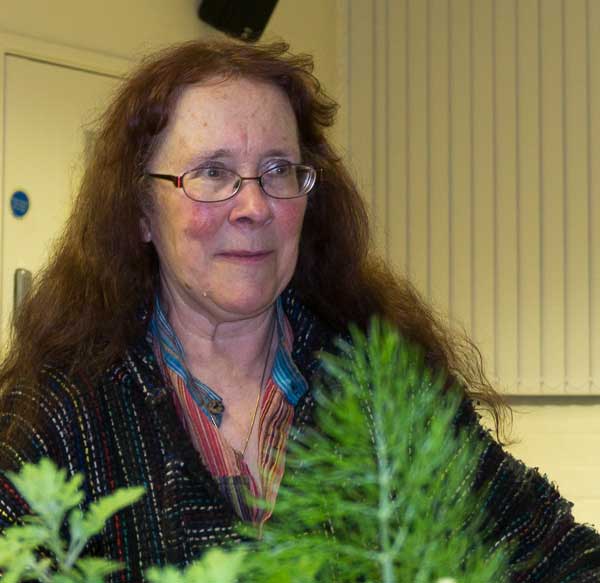
In earlier centuries, every village had its own witch, or the equivalent, and that was the person you turned to for herbal remedies for illness, injuries and love making—as well as births and deaths.
Lynne described the history of herbs in these self contained commmunities where there wasn't the money to pay for a "doctor". To a certain extent this was still true up to the birth of the National Health Service in 1948.
As well as graphic and entertaining descriptions of a massive range of English herbs, Lynne had a large number of them on the table in front of her: we could test their smells ourselves at the end of her presentation—and buy them if we wished.
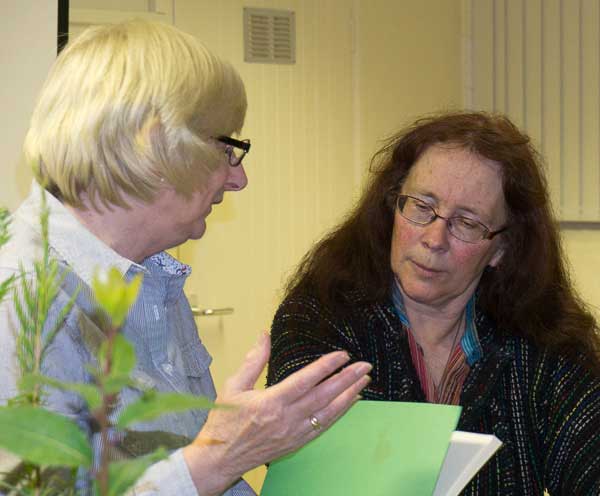
Lynne has published several books on herbs and sells herb plants at her plant centre, "The Witches Garden", near Ashby-de-Zouch.
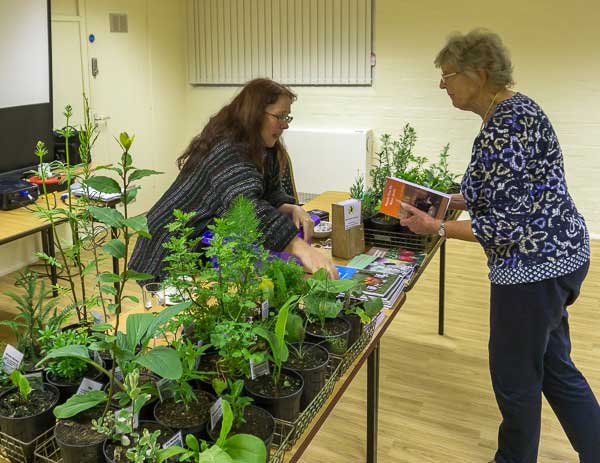
Tony Jarrow
On Thursday 11th May, Cropwell Bishop Gardening Club made their first garden visit of 2017. It was to "Woodpeckers " at Burton where they saw an amazing collection of rhodedenrons and azaleas.
Judy Thomas
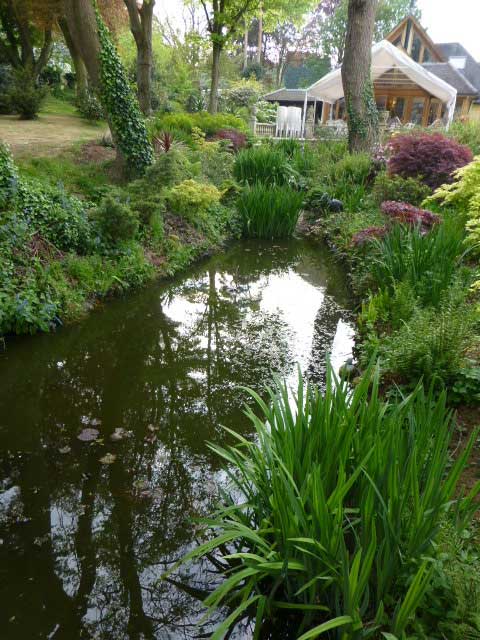
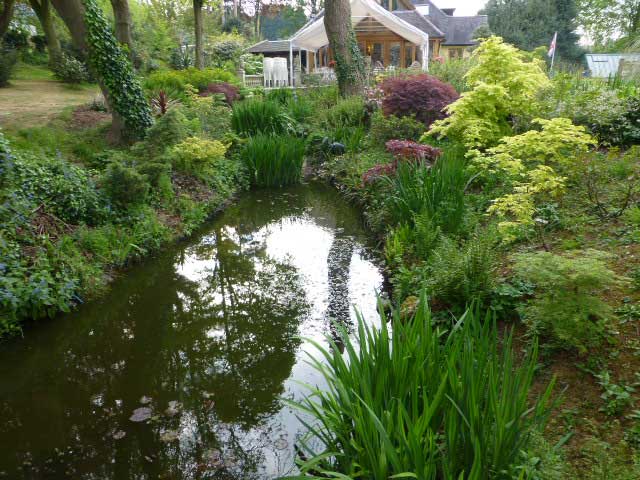
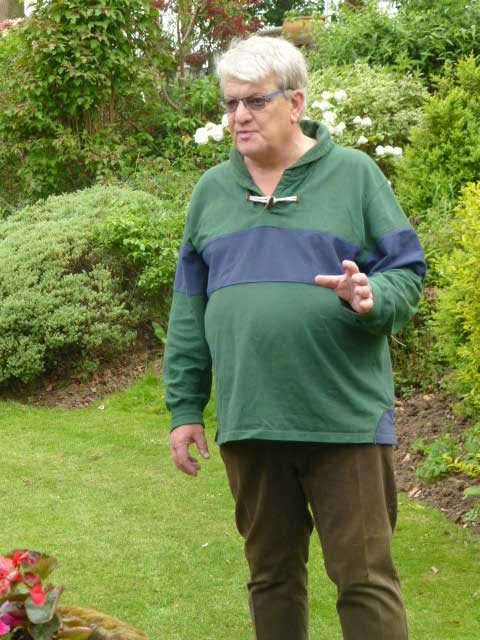
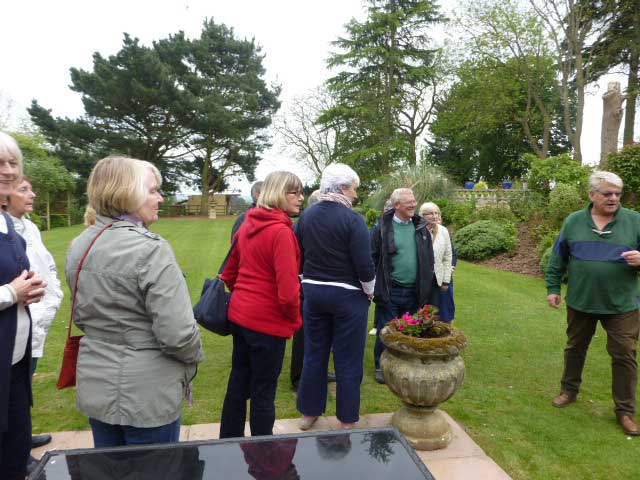
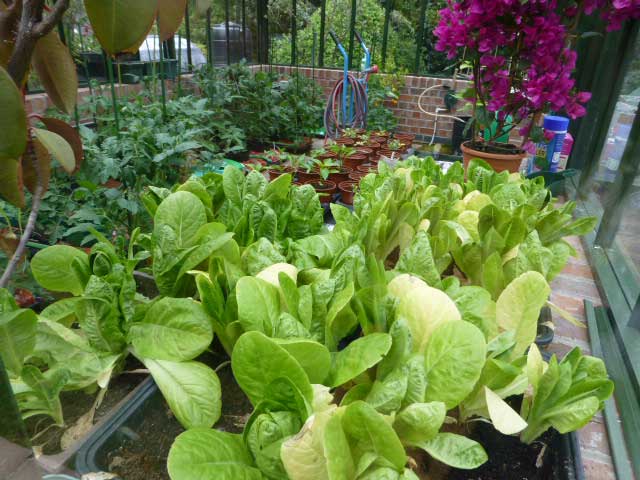



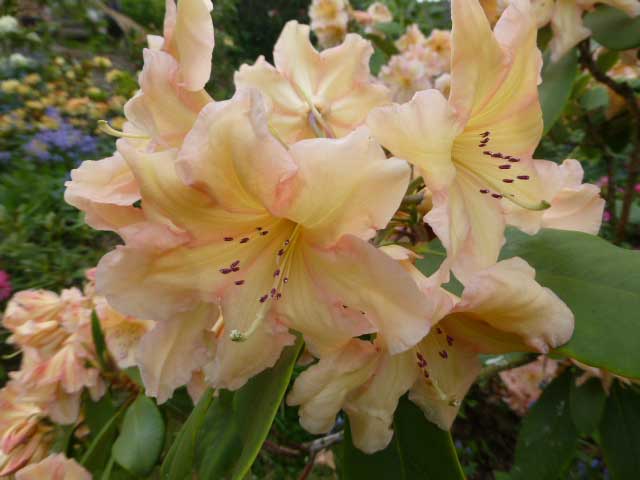
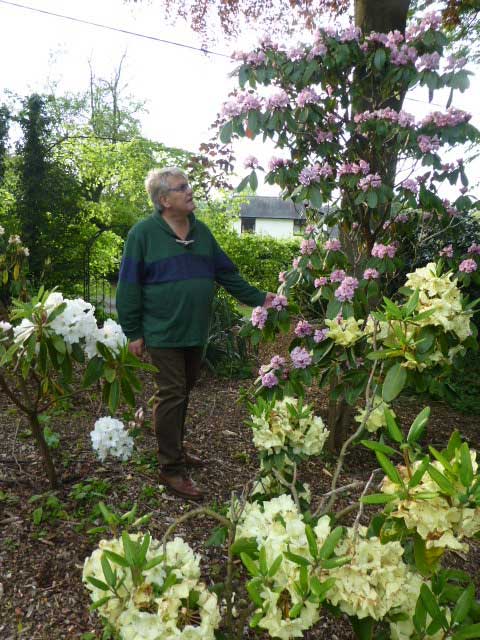
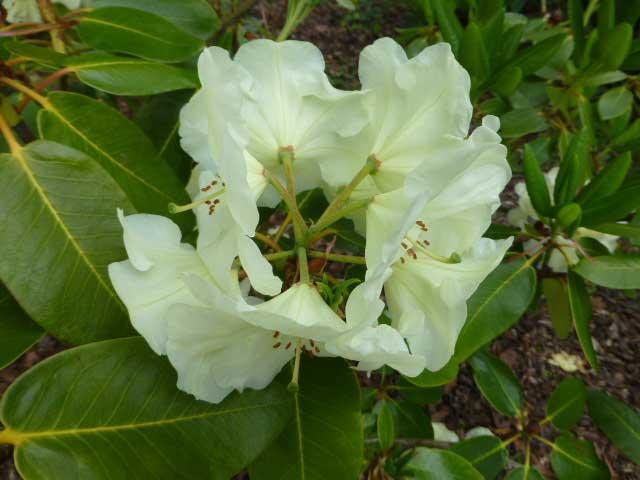

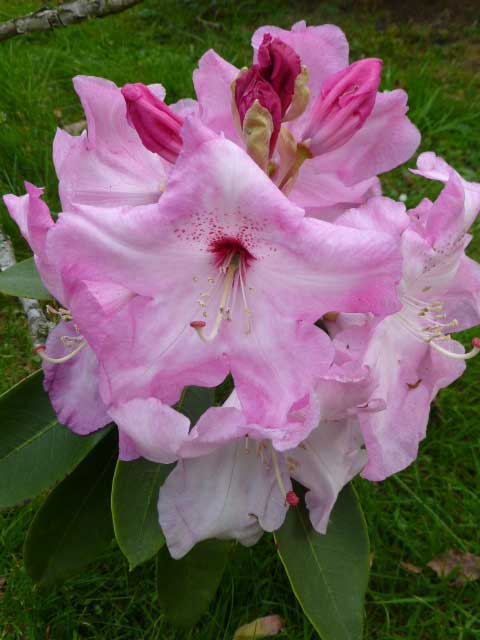
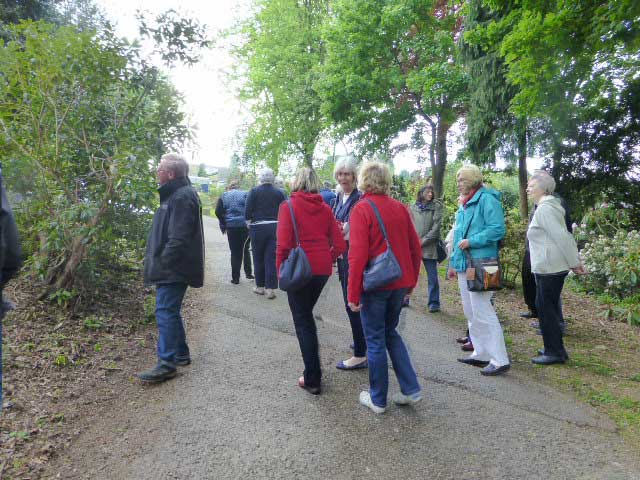
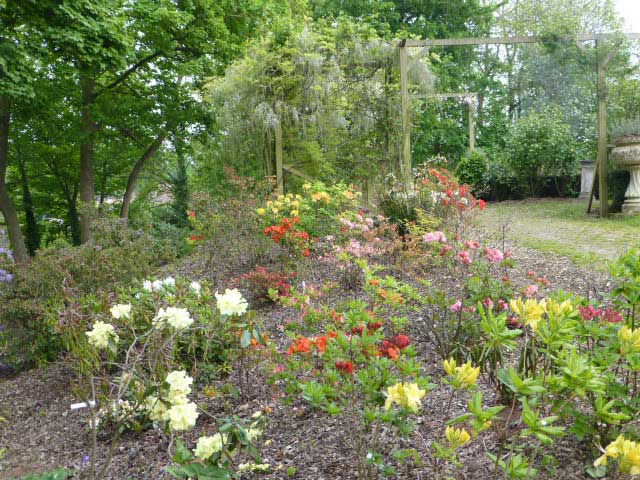
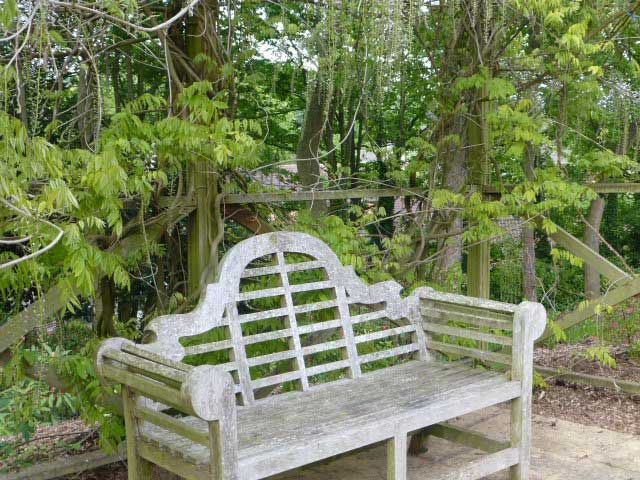

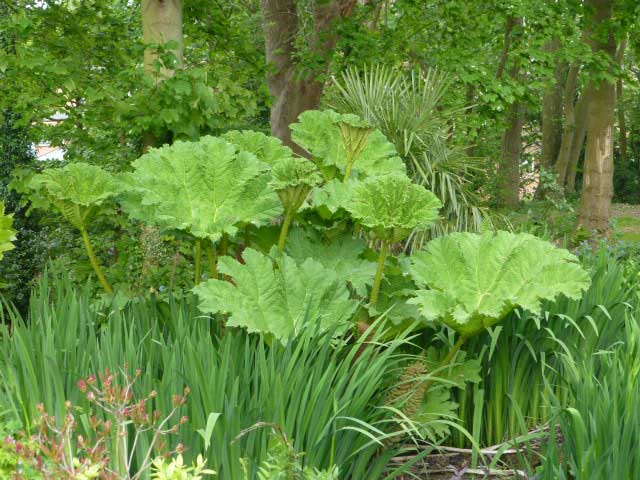


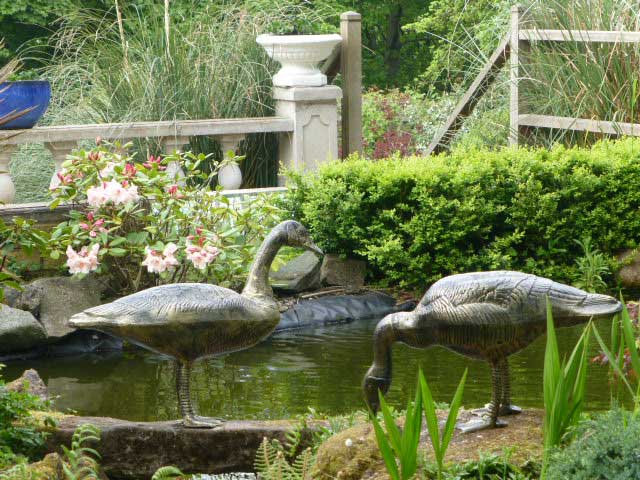
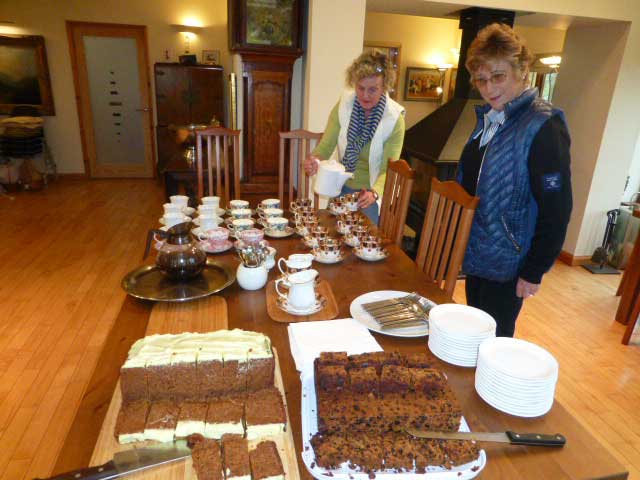
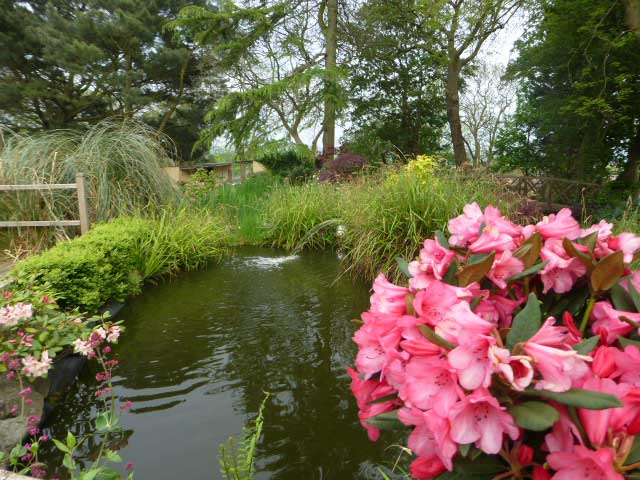
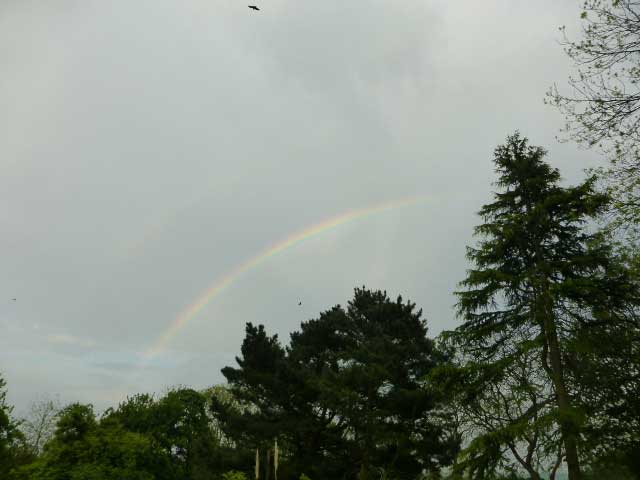
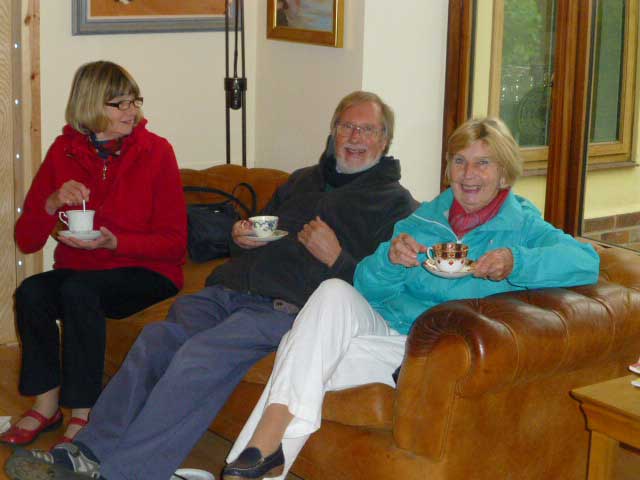

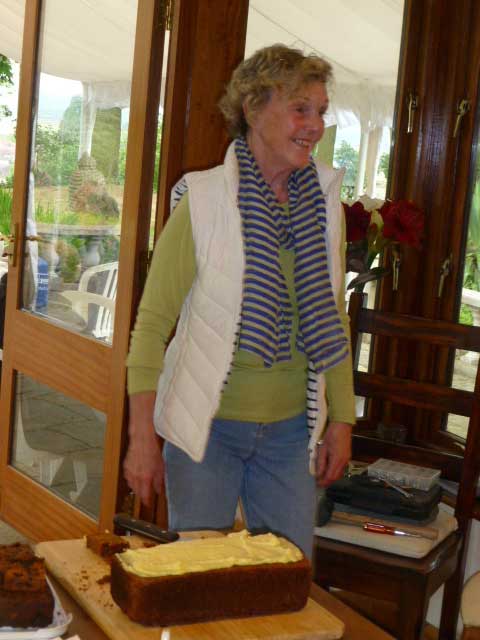
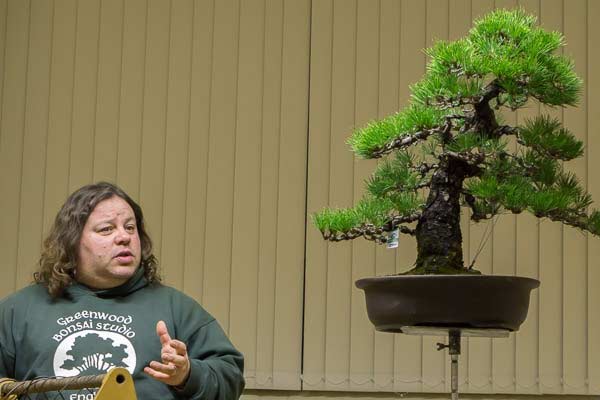 If you are like me then you always thought that growing miniature trees in shallow trays of soil was something that demanded an artist with a delicate hand. This evening we were shown a very different aspect of Bonsai growing by an artist who was not afraid to attack with gusto the task of training a young tree to grow more slowly.
If you are like me then you always thought that growing miniature trees in shallow trays of soil was something that demanded an artist with a delicate hand. This evening we were shown a very different aspect of Bonsai growing by an artist who was not afraid to attack with gusto the task of training a young tree to grow more slowly.
 Almost 30 people from the Gardening Club were introduced to the world of Bonsai by local expert Corin Tomlinson who owns and runs the Greenwood Bonsai Studio on Ollerton Road in Arnold. He explained the background to Bonsai trees and described his busy life of collecting young specimens from around the world, meeting other experts, teaching students of Bonsai and also running his Bonsai business.
Almost 30 people from the Gardening Club were introduced to the world of Bonsai by local expert Corin Tomlinson who owns and runs the Greenwood Bonsai Studio on Ollerton Road in Arnold. He explained the background to Bonsai trees and described his busy life of collecting young specimens from around the world, meeting other experts, teaching students of Bonsai and also running his Bonsai business.
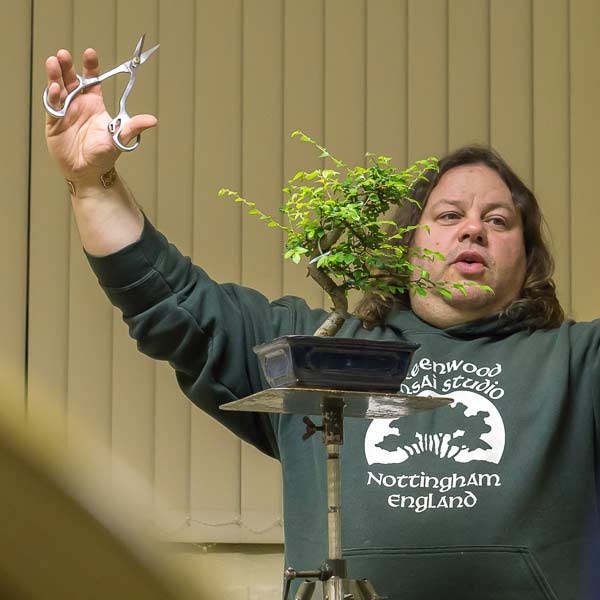 Naturally he had specimens of Bonsai trees but surprised us by how much regular attention the trees require: regular pruning, repotting, wiring, feeding and, most important, watering every day.
Naturally he had specimens of Bonsai trees but surprised us by how much regular attention the trees require: regular pruning, repotting, wiring, feeding and, most important, watering every day.
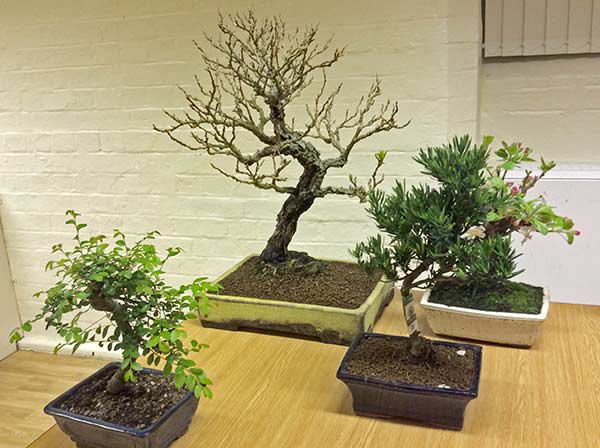 Following this gentle introduction to Bonsai we were taken by surprise when he plonked a big conifer onto this workbench—the kind you see in the reduced section of a Gardening Centre at the end of the season. What could this have to do with the gentle art of Bonsai?
Following this gentle introduction to Bonsai we were taken by surprise when he plonked a big conifer onto this workbench—the kind you see in the reduced section of a Gardening Centre at the end of the season. What could this have to do with the gentle art of Bonsai?
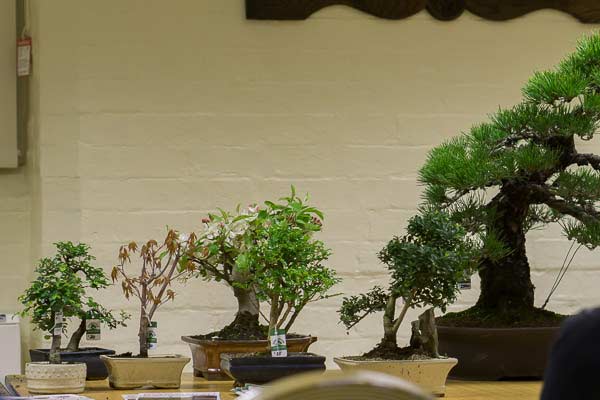 Corin was no longer going to just talk about Bonsai, he was going to show us the art of Bonsai in just 45 minutes! He put on a great show, peppered with stories and jokes. He made the job of converting an ordinary conifer specimen into the beginnings of a Bonsai tree look easy.
Corin was no longer going to just talk about Bonsai, he was going to show us the art of Bonsai in just 45 minutes! He put on a great show, peppered with stories and jokes. He made the job of converting an ordinary conifer specimen into the beginnings of a Bonsai tree look easy.
Of course, all experts have the knack of making difficult things look easy but, even so, we were left with the urge to rush home and grab that pot-bound conifer in the back garden. By the end of tomorrow it would be the envy of every one of your garden visitors—even the Chinese ones, who knew a thing or two about this art.
 If you doubt this was possible, take a look at the sequence of photos below (first the left-hand column, then the right-hand one). Those still lacking courage can always book into one of Corin Tomlinson's Training Sessions at Arnold.
If you doubt this was possible, take a look at the sequence of photos below (first the left-hand column, then the right-hand one). Those still lacking courage can always book into one of Corin Tomlinson's Training Sessions at Arnold.
Tony Jarrow
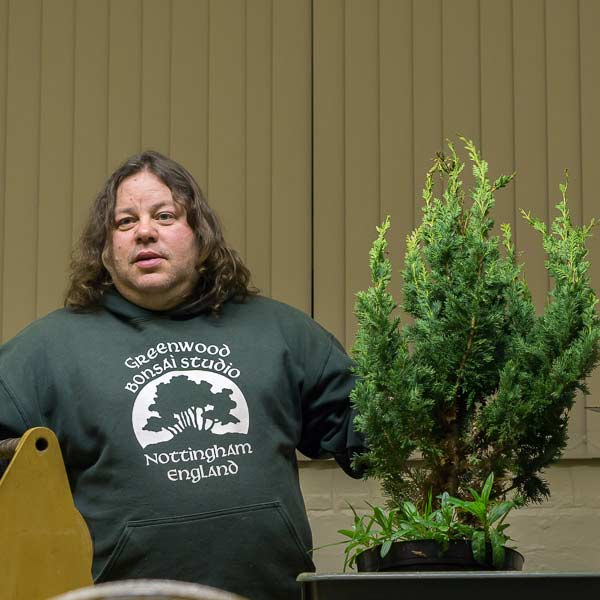
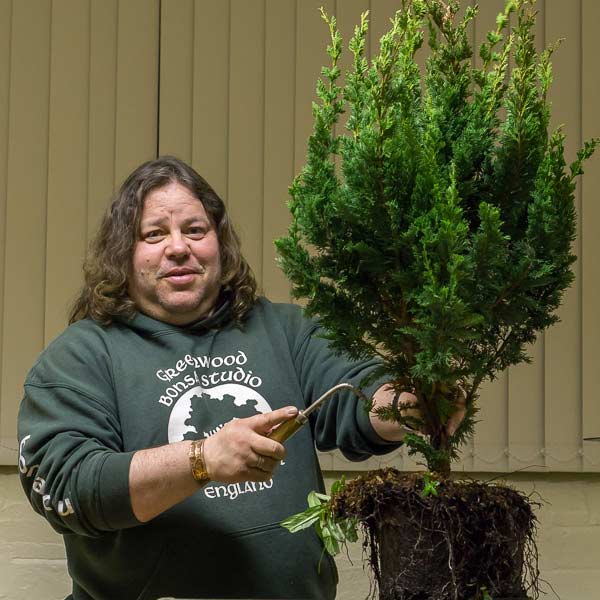

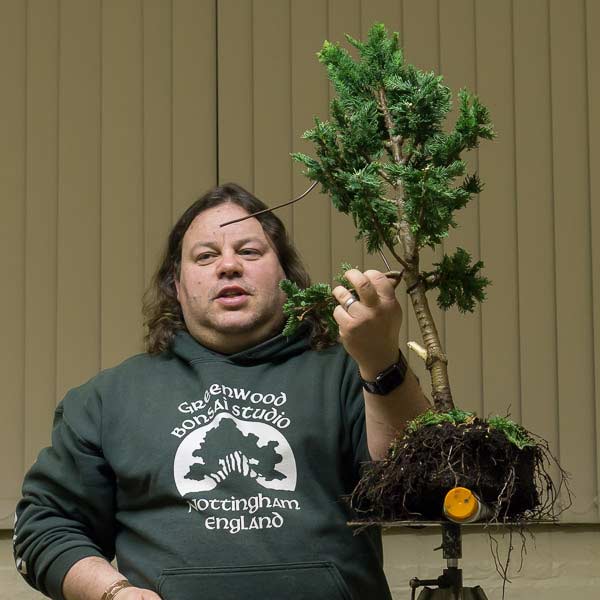
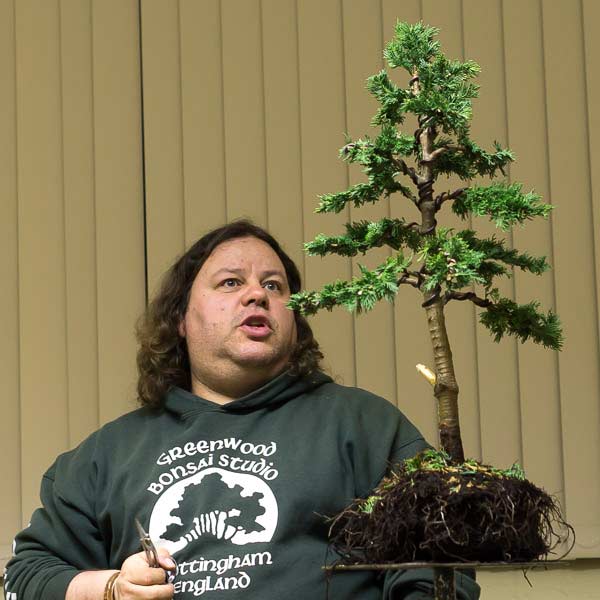
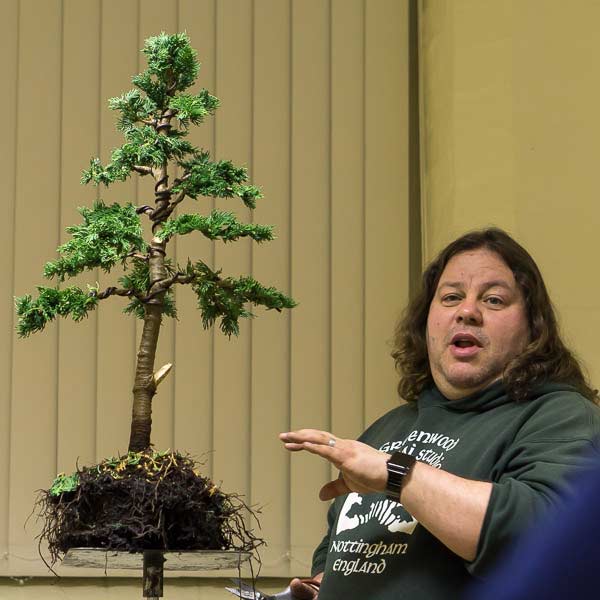
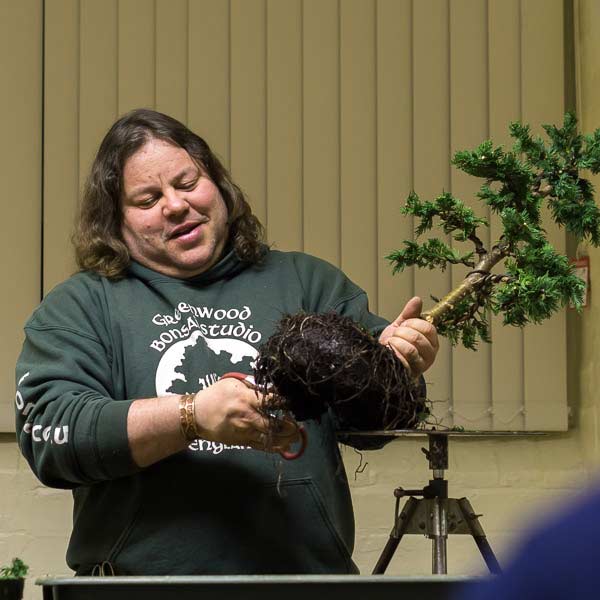
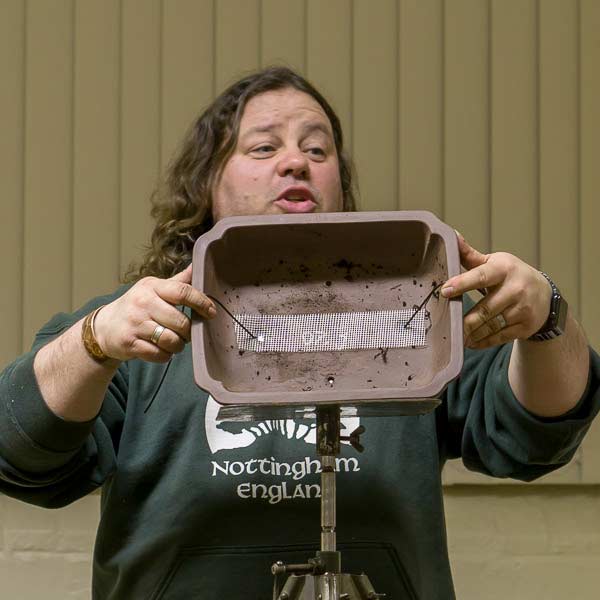



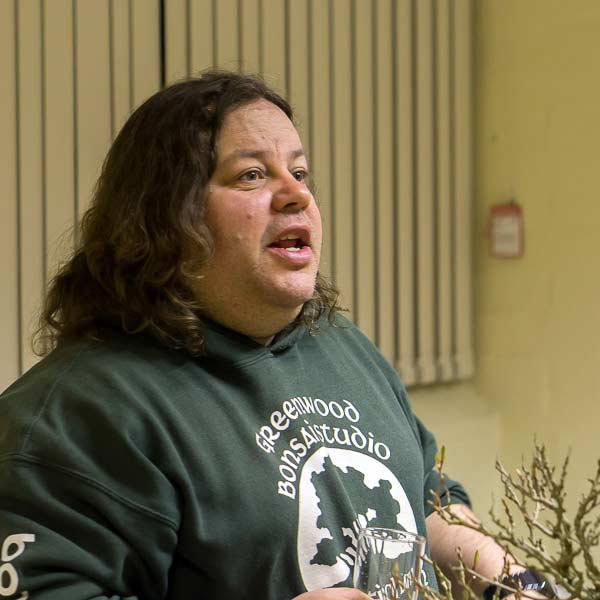
For our first meeting of the New Year we were treated to a feast of amusing and entertaining anecdotes together with an introduction to the finer points of hedgelaying from our guest speaker Clive Matthew.

Clive has over 40 years experience in hedgelaying and has won numerous trophies and titles in nationwide competitions including Supreme Champion Hedgelayer.
Having left school at fourteen, Clive told us of his early days working on his father’s farm, getting up at 5.30am for milking and being left to demolish the old piggeries whilst his parents were holidaying on the Isle of Wight!
He later found work with the Scottish Relief Milking Service, having many adventures, narrowly escaping Salmonella poisoning in one particularly unsavoury farm and being propositioned at the tender age of 18 by a ‘lady’ farmer in Exeter!
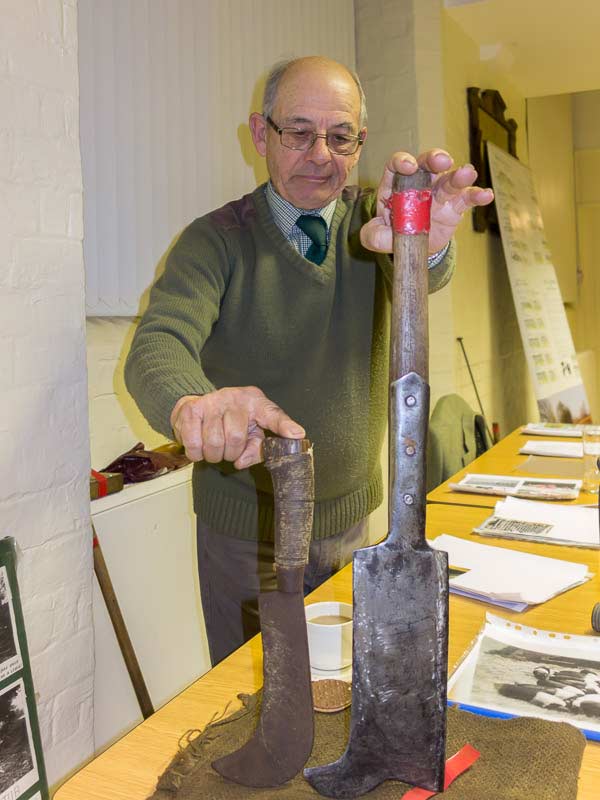
Eventually his interest in the skill of hedgelaying led to the formation in 1978 of The National Hedgelaying Society together with two others who were just as passionate to ensure that this ancient and useful art should not be allowed to die out. They recognised the importance of hedging being sustained as protection for livestock and crops, as well as providing a haven for wildlife.
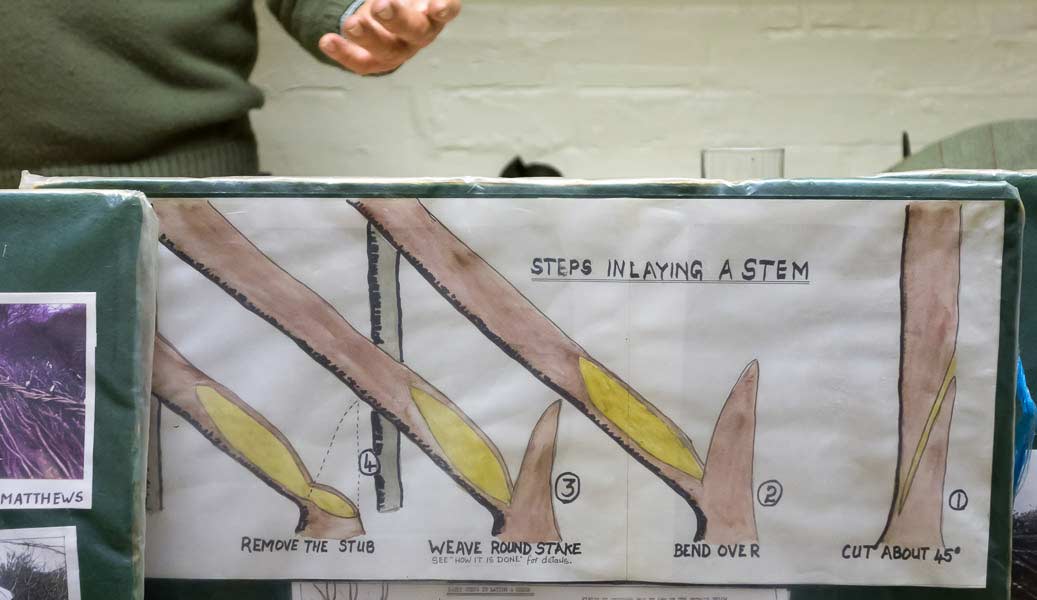
We were introduced to technical terms such as PLEACHER—the cut stem which is then bent and woven into the hedge and reminded of the use of ‘Chain’ as a unit of measurement of length.

Together with a formidable collection of Billhooks, used for cutting, Clive also brought along his own apple wood MAUL a large mallet used to hammer stakes into the ground. This was much coveted by H.R.H Prince Charles when he saw it being used at Tetbury. Clive offered to make him one but refused to give his own away—even to royalty!
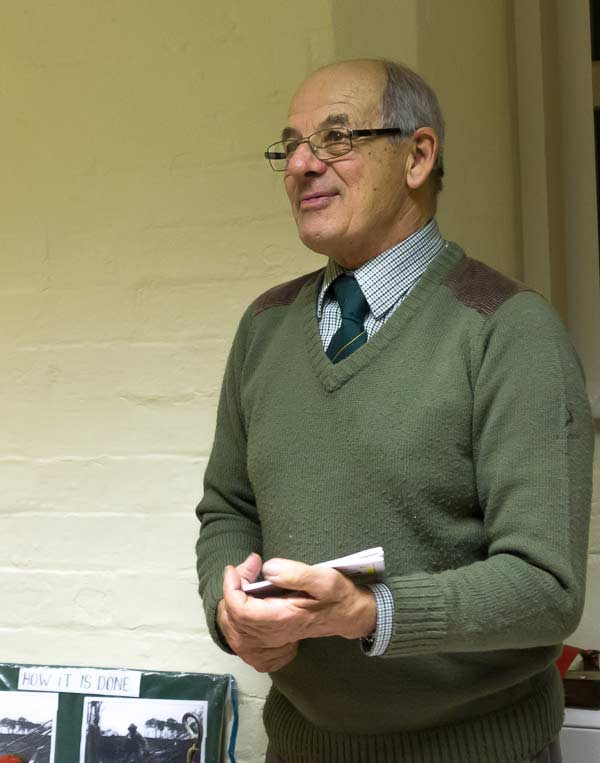
Thanks to Clive’s enthusiastic and informative presentation, we will not be able to look at hedging in the same way again. He certainly livened up a dull January evening and we wish him well in any future competitions.

Clive donated his fees to the charity—Disabled Christian Fellowship Holidays—which he actively supports.
G.G. January 2017